senses and perception
1/83
There's no tags or description
Looks like no tags are added yet.
Name | Mastery | Learn | Test | Matching | Spaced | Call with Kai |
|---|
No study sessions yet.
84 Terms
bottom-up processing
analysis that begins with the sensory receptors and works up to the brain's integration of sensory information. Requires no prior knowledge and takes place as it is happening.
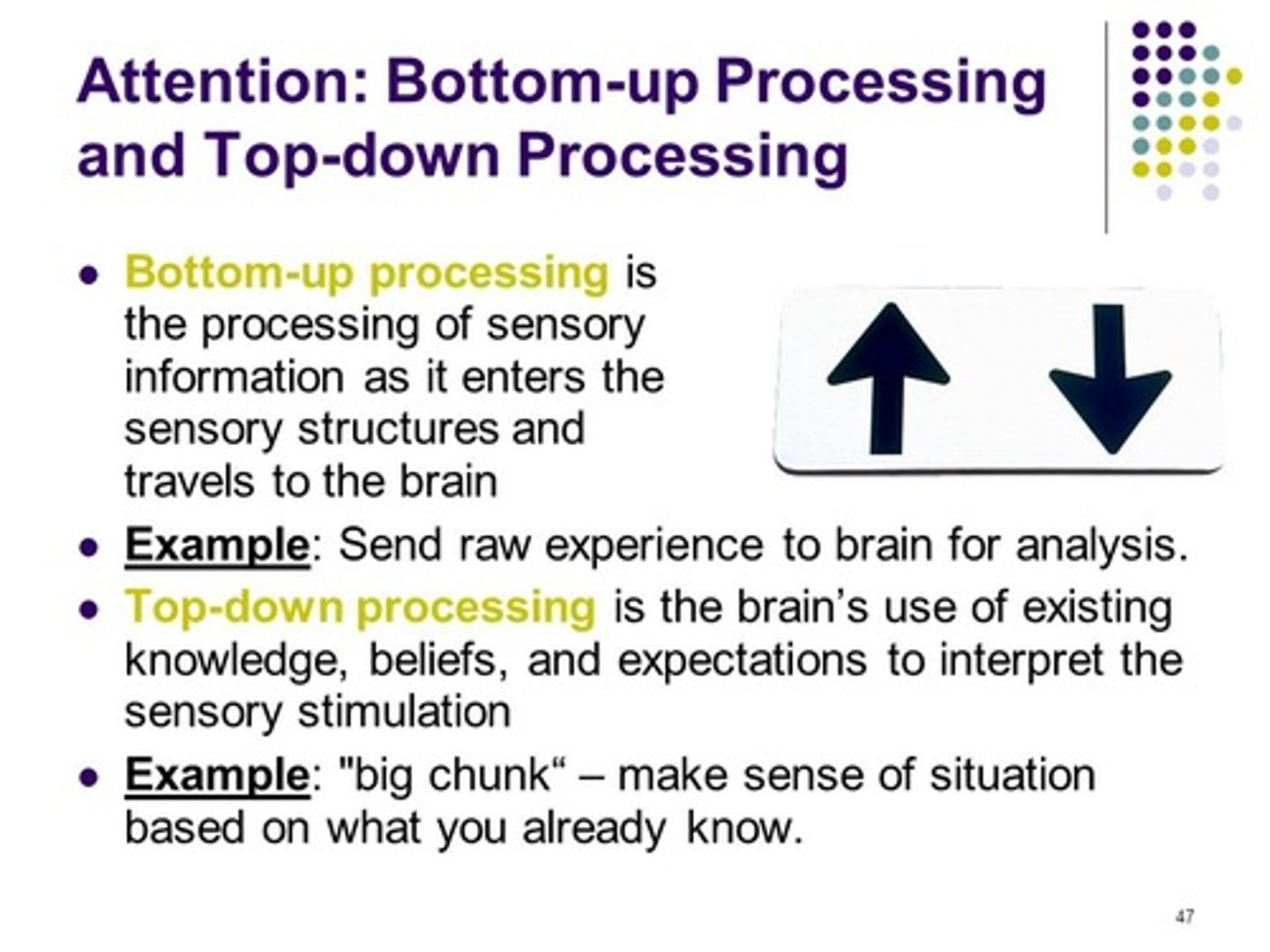
top-down processing
A cognitive process that initiates with our thoughts, which flow down to lower-level functions, such as the senses. Your brain applies what it knows to fill in the blanks and anticipate what's next.
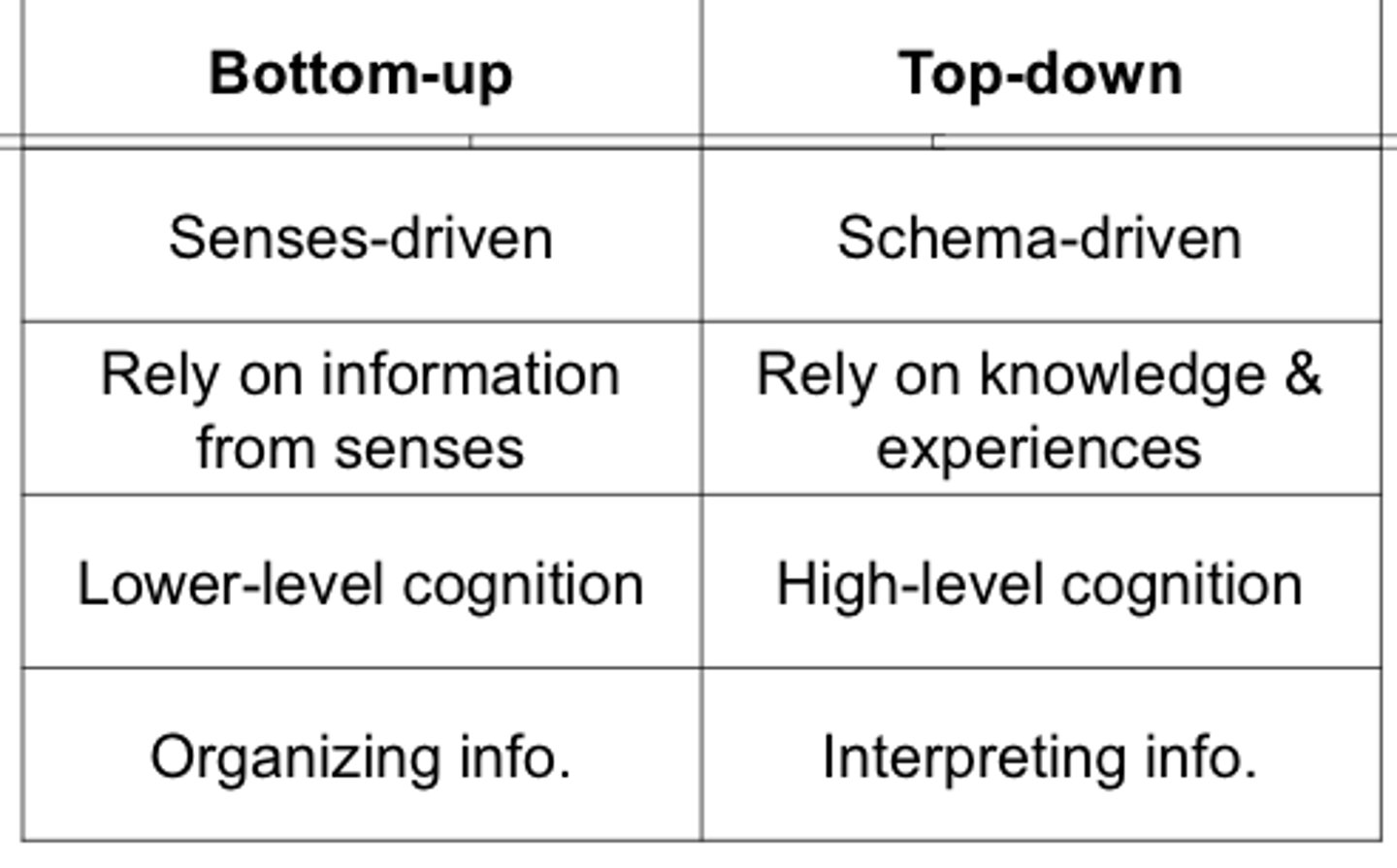
selective attention
Ability to pay attention to a limited array of all available sensory information. Helps prioritize information according to its importance, is adaptive. (Ex. multitasking will lead to missing critical info due to not given attention...doing homework while watching tv).
transduction
Conversion of one form of energy into another. In sensation, the transforming of stimulus energies, such as sights, sounds, and smells, into neural impulses our brain can interpret.
absolute threshold
The minimum stimulation needed to detect a particular stimulus 50 percent of the time. Originally the lowest level of a stimulus - light, sound, touch, etc. - that an organism could detect. Will be different for different people...Joe can hear the whisper but Jane can't.
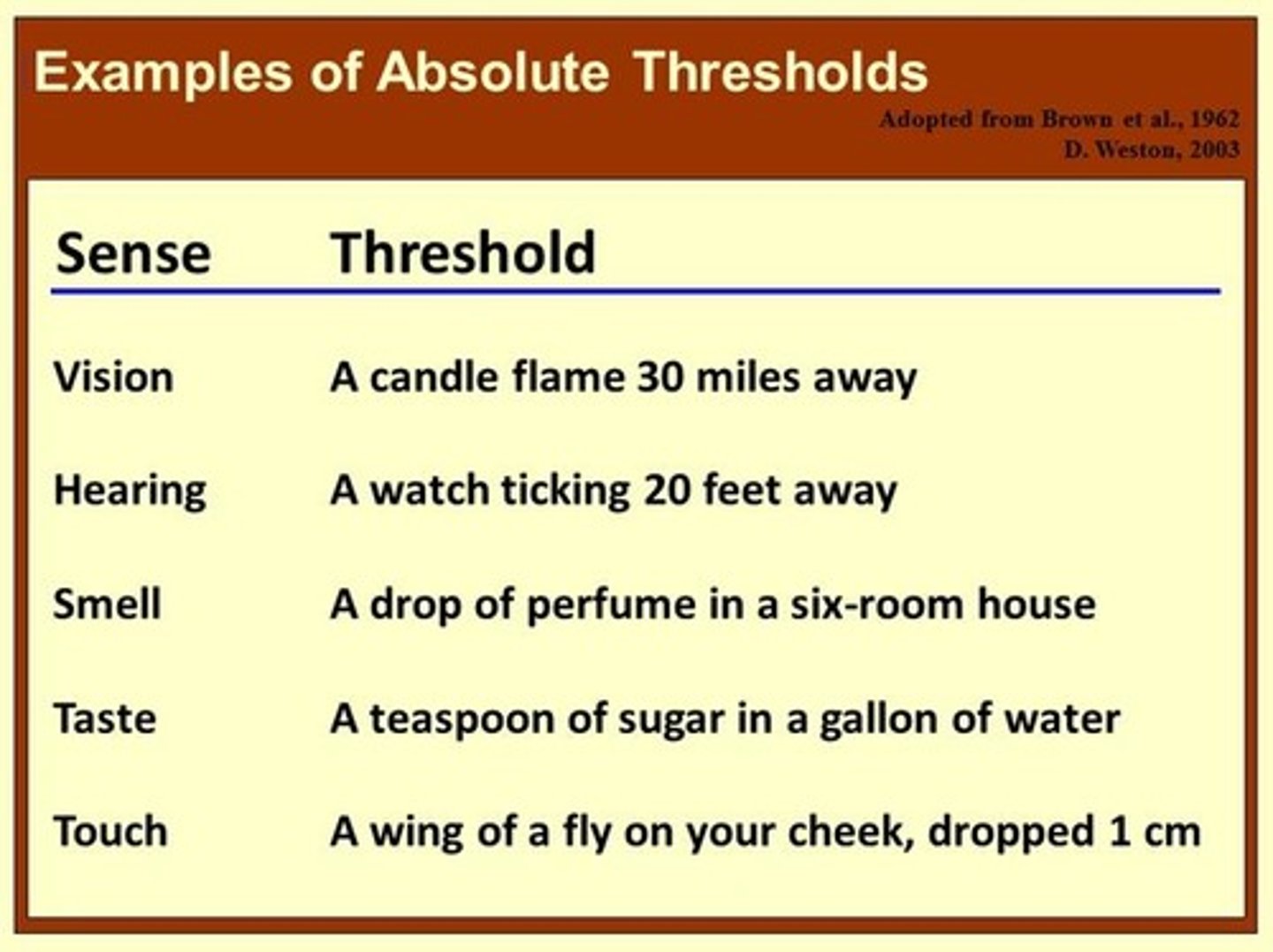
signal detection theory
a theory predicting how and when we detect the presence of a faint stimulus (signal) amid background stimulation (noise). Assumes there is no single absolute threshold and that detection depends partly on a person's experience, expectations, motivation, and alertness. (Ex. mom can hear her baby cry in a noisy house...because she wants/needs to)
subliminal
A stimulus that is below one's absolute threshold for conscious awareness or detection. Can be used to prime us but not persuade or change us long term.
difference threshold (aka Just Noticeable Difference)
The amount of change needed in a stimulus for us to notice there was a change 50 percent of the time. The greater the intensity of the stimulus the greater the change needed to produce a noticeable change. (ex. weight... 300lb person loses 3 lbs they don't notice!)
Weber's law (aka Weber-Fechner law)
A psychophysical law states... for the intensity of a stimulus to be perceived psychologically as different, the two stimuli must differ by a constant minimum percentage (rather than a constant amount). The intensity of the stimulus corresponds to the psychological sensation. (Developed by Ernst Weber & Gustav Fechner)
sensory adaptation
Neural or sensory receptors reduce their sensitivity to a continuous unchanging stimulus. Ex. Jump in a pool feels very cold but then after sitting in it for an hour you get used to it. Senses adapt. (don't notice it after awhile) NOT habituation!!
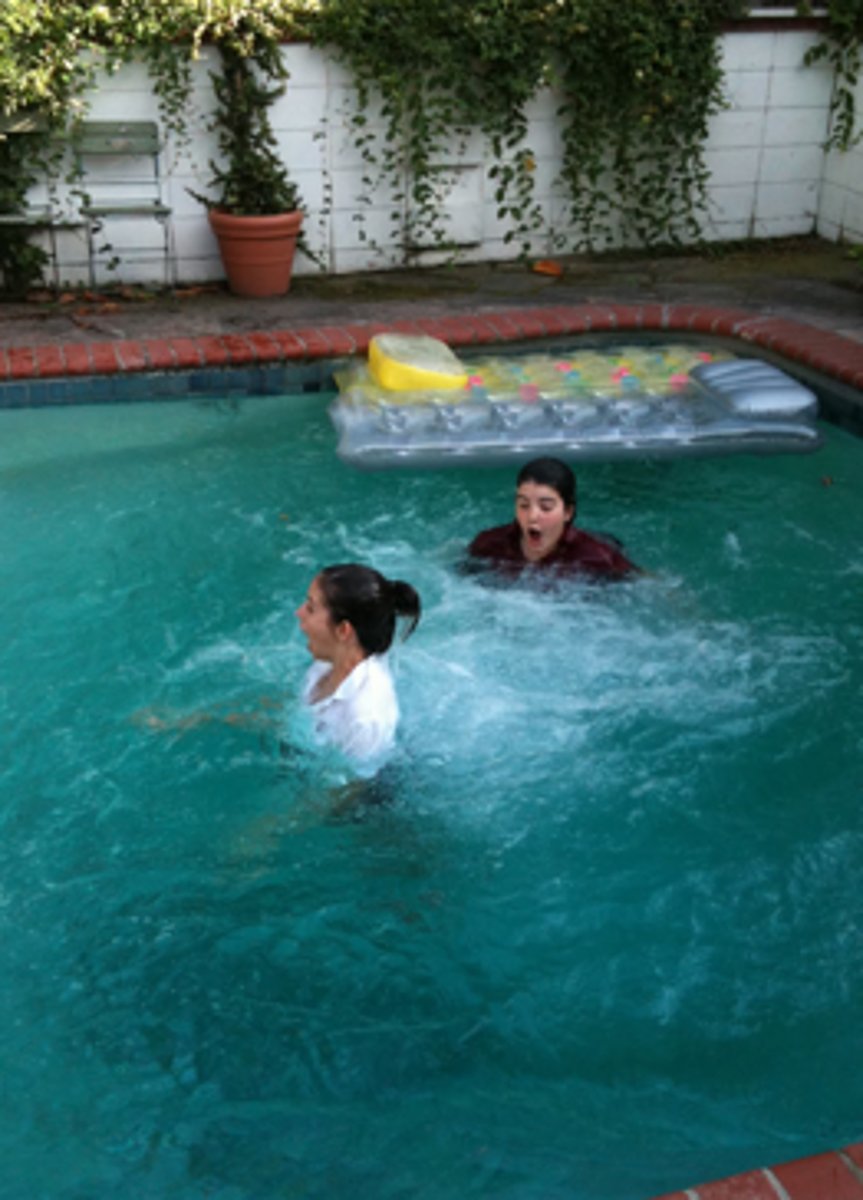
perceptual set (aka perceptual expectancy)
A readiness to perceive certain objects or events rather than others. Can differ due to individual life experiences, memories, beliefs, and personal motivations. Impacts how we encounter and navigate new information and new experiences. Occurs in all the different senses.

parapsychology
The study of paranormal phenomena, including ESP, psychokinesis, telepathy, clairvoyance and precognition.
wavelength
The distance from the peak of one light or sound wave to the peak of the next. Short or long = pitch of sound and is connected to frequency.
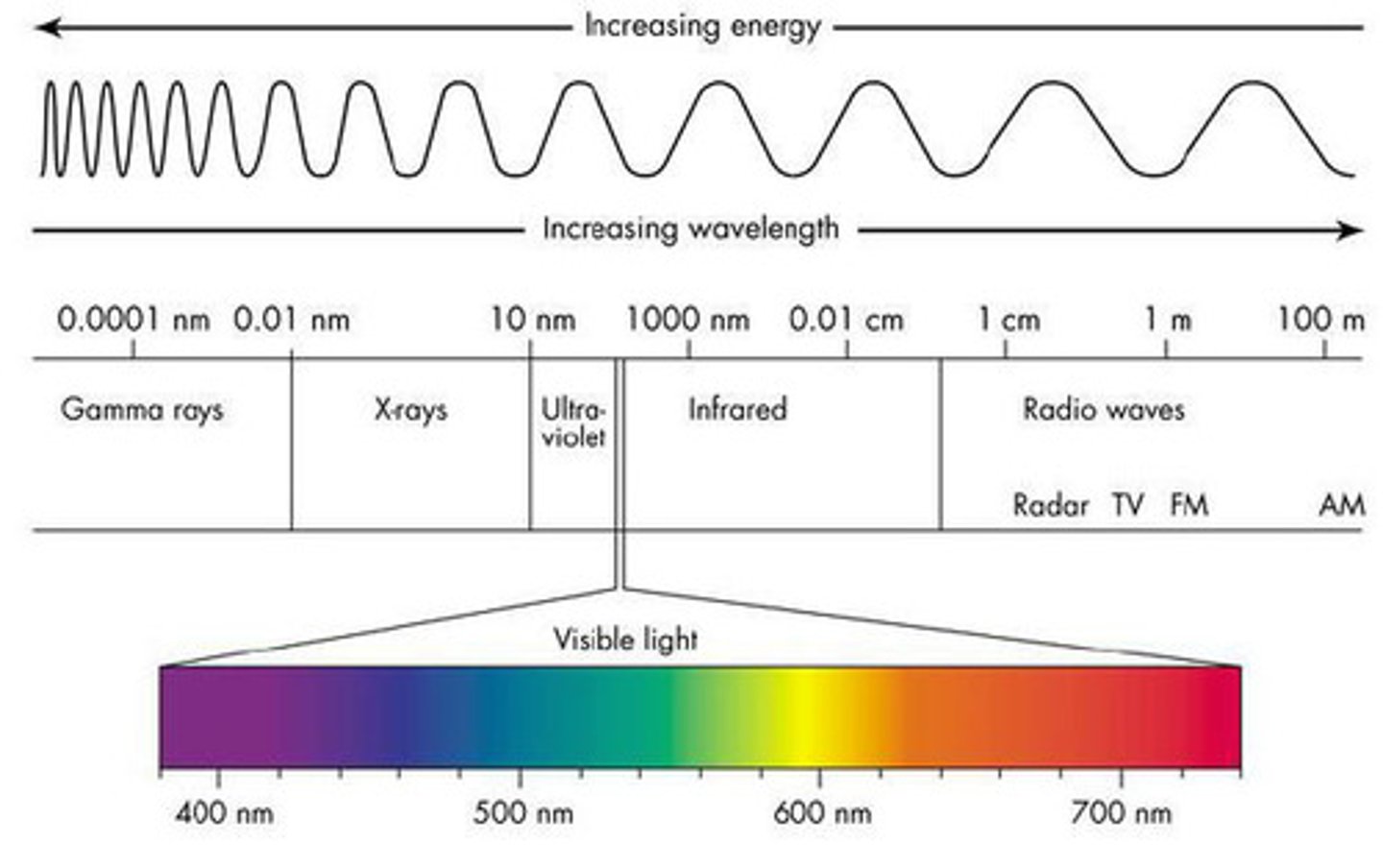
hue
The dimension of color that is determined by the wavelength of light; what we know as the color names blue, green, and so forth. (The pitch for sound is like hue for light)
pupil
The adjustable opening in the center of the eye through which light (photons) enters.
lens
The transparent structure behind the pupil that changes shape to help focus images on the retina.
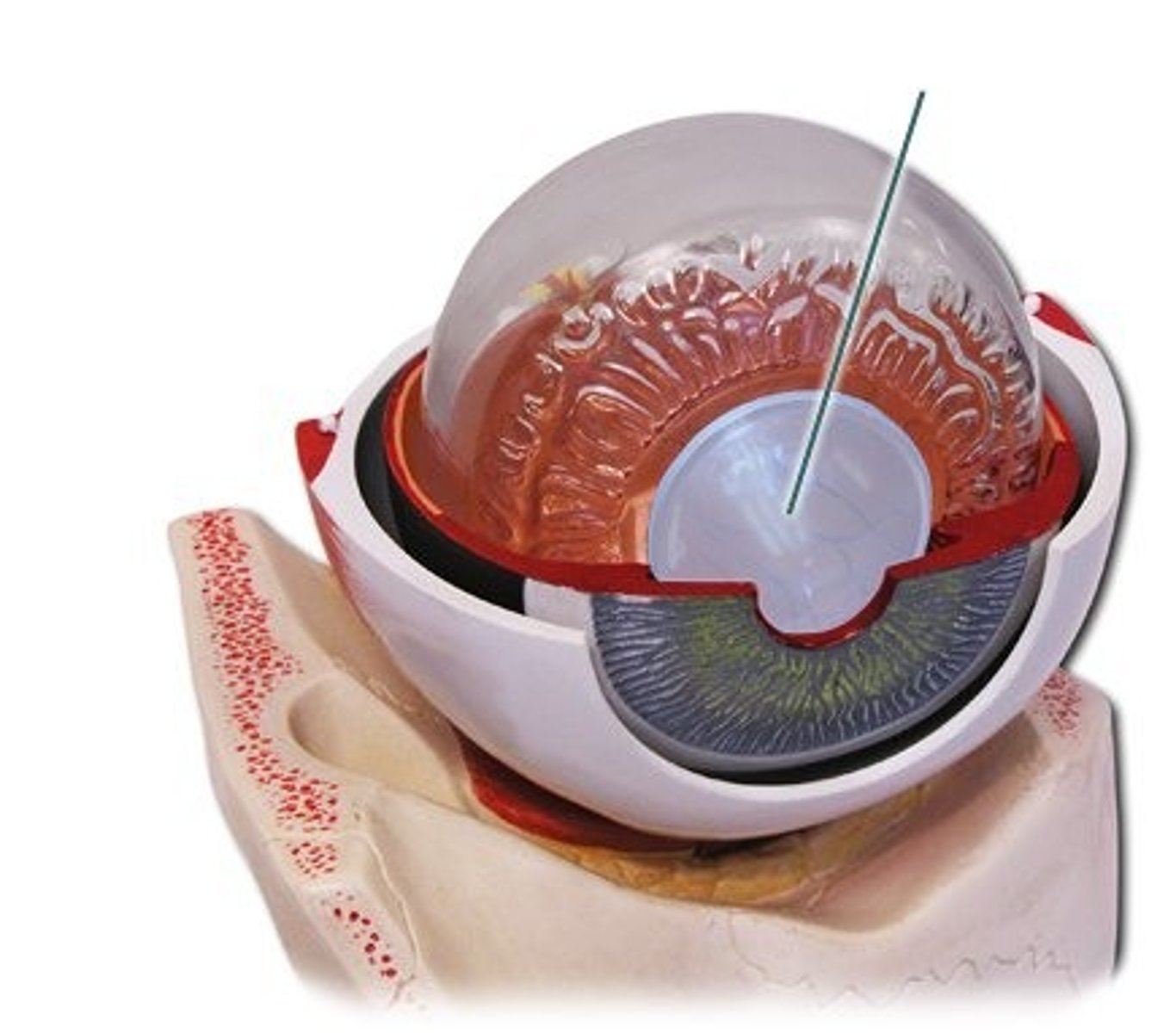
retina
The light-sensitive inner surface of the eye, containing the photoreceptors of rods and cones plus layers of neurons that begin the processing of visual information. Visual transduction takes place here.
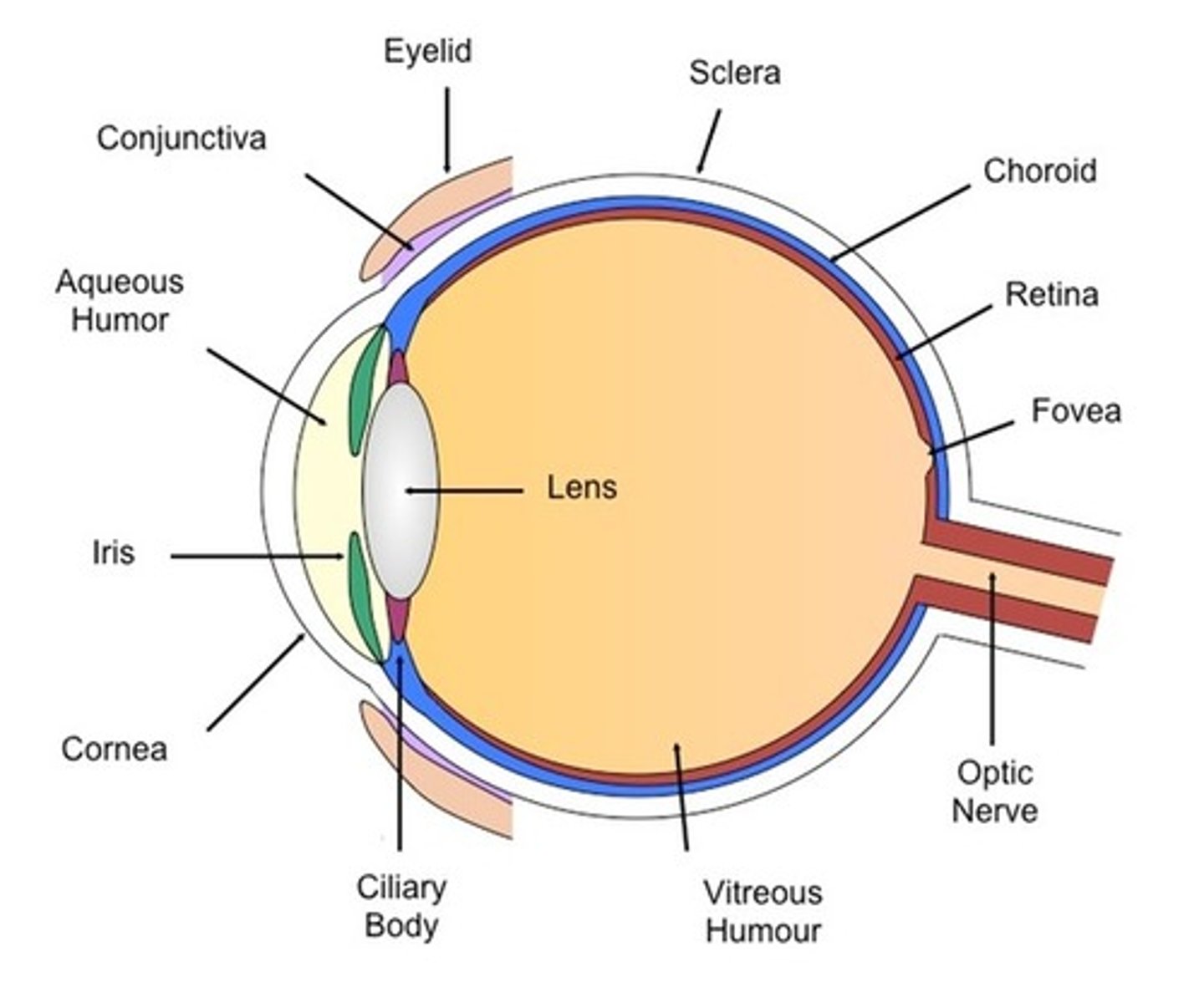
rods
Retinal photoreceptors that detect black, white, and gray; necessary for peripheral and twilight vision, when cones don't respond. They are not found in the fovea therefore they are more sensitive in the dark. These photoreceptors like photoreceptor cones and relay visual information to the brain through the bipolar and ganglion cells.
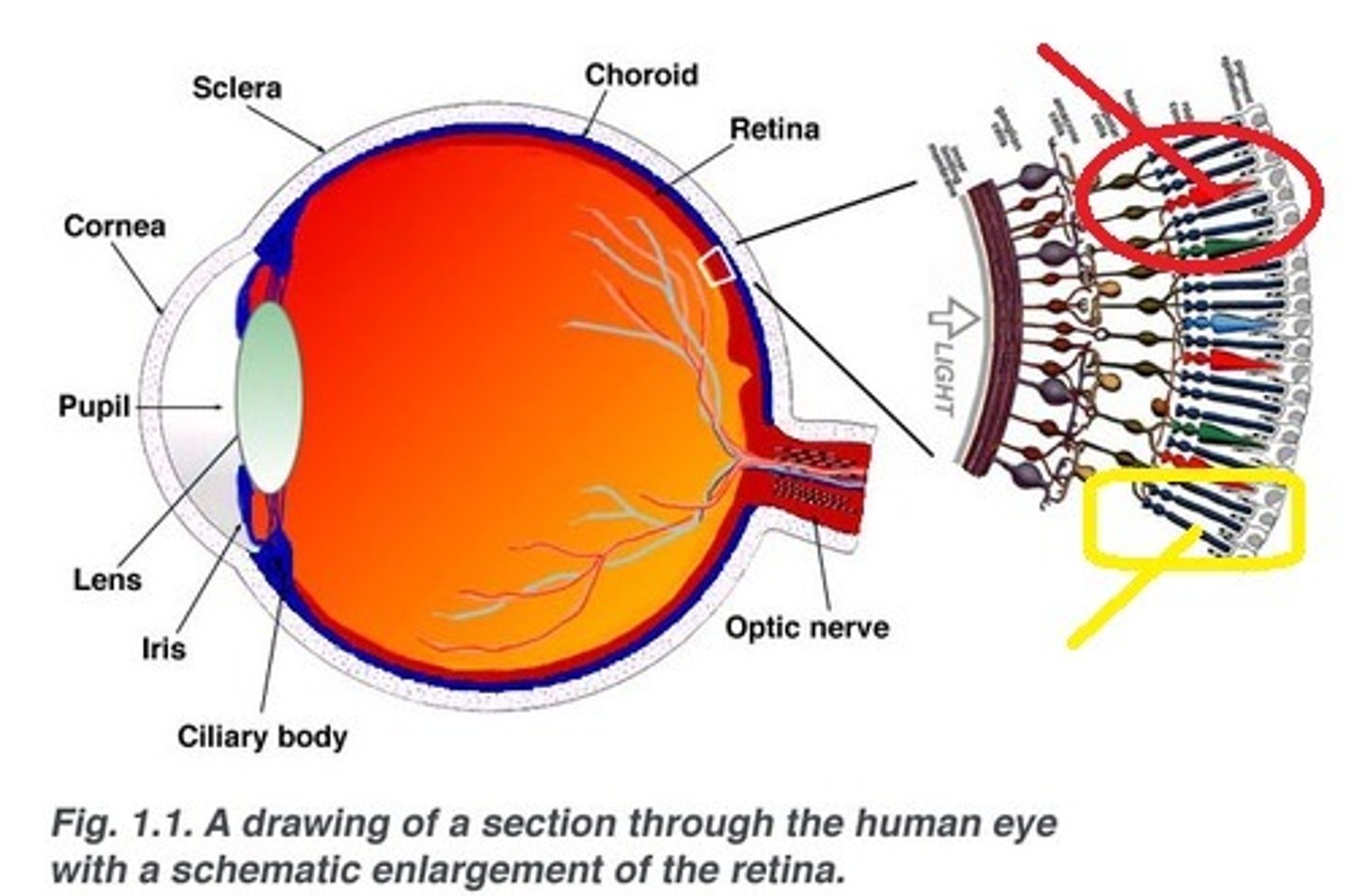
cones
Retinal photoreceptor cells that are concentrated near the center of the retina and that function in daylight or in well-lit conditions. The eye relies on the cones to detect color but they do not work well in dim light.
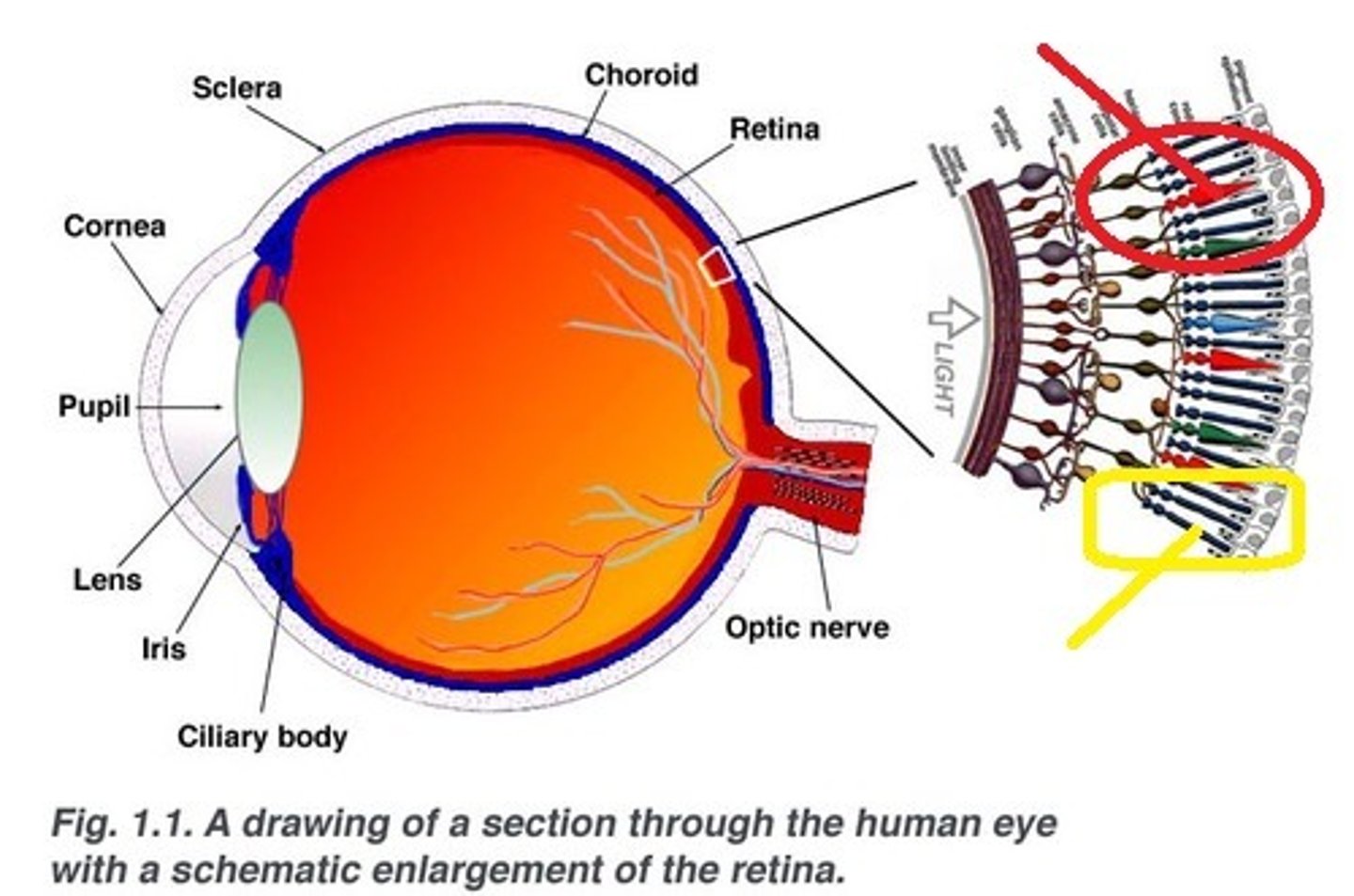
optic nerve
The nerve that carries neural impulses from the eye to the brain.
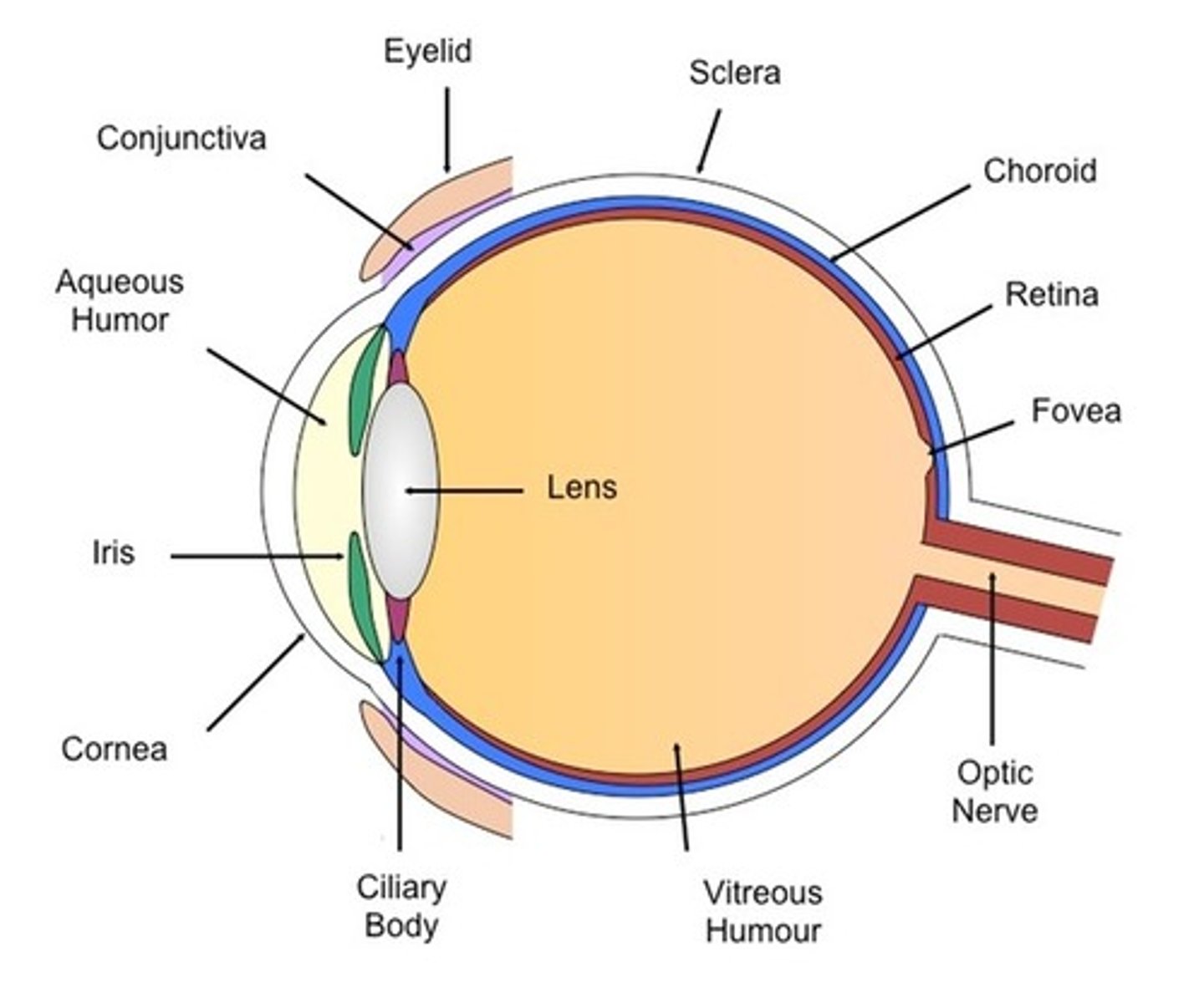
blind spot
The point at which the optic nerve exits the eye going to the brain, creating a "blind" spot because no receptor cells are located there. We don't notice it because the brain fills in the missing space so the visual field doesn't seem incomplete. NOT "blind sight"!!
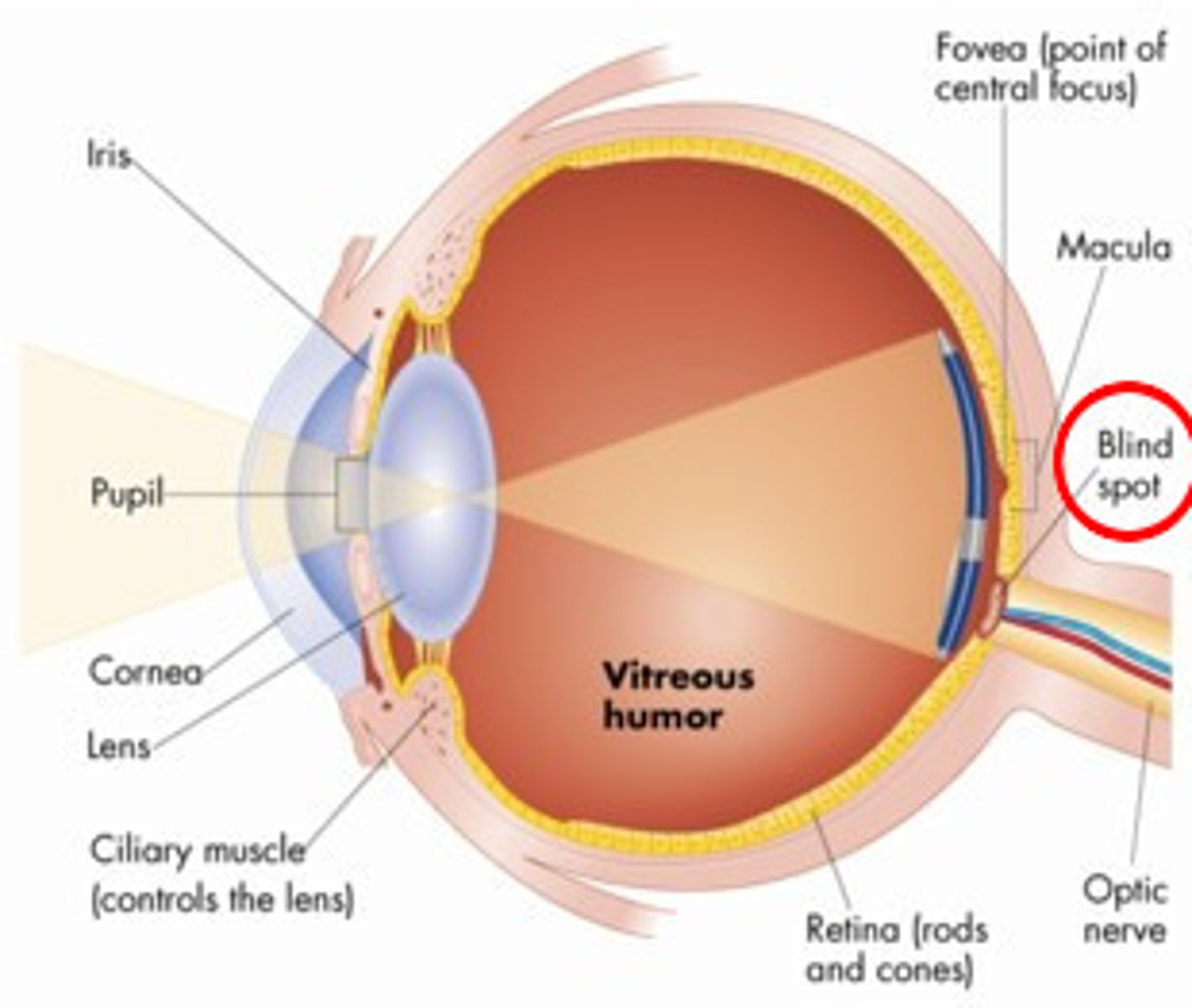
fovea
The central focal point in the retina, around which the eye's cones cluster. There are no rods present so the greatest visual acuity is in bright light.
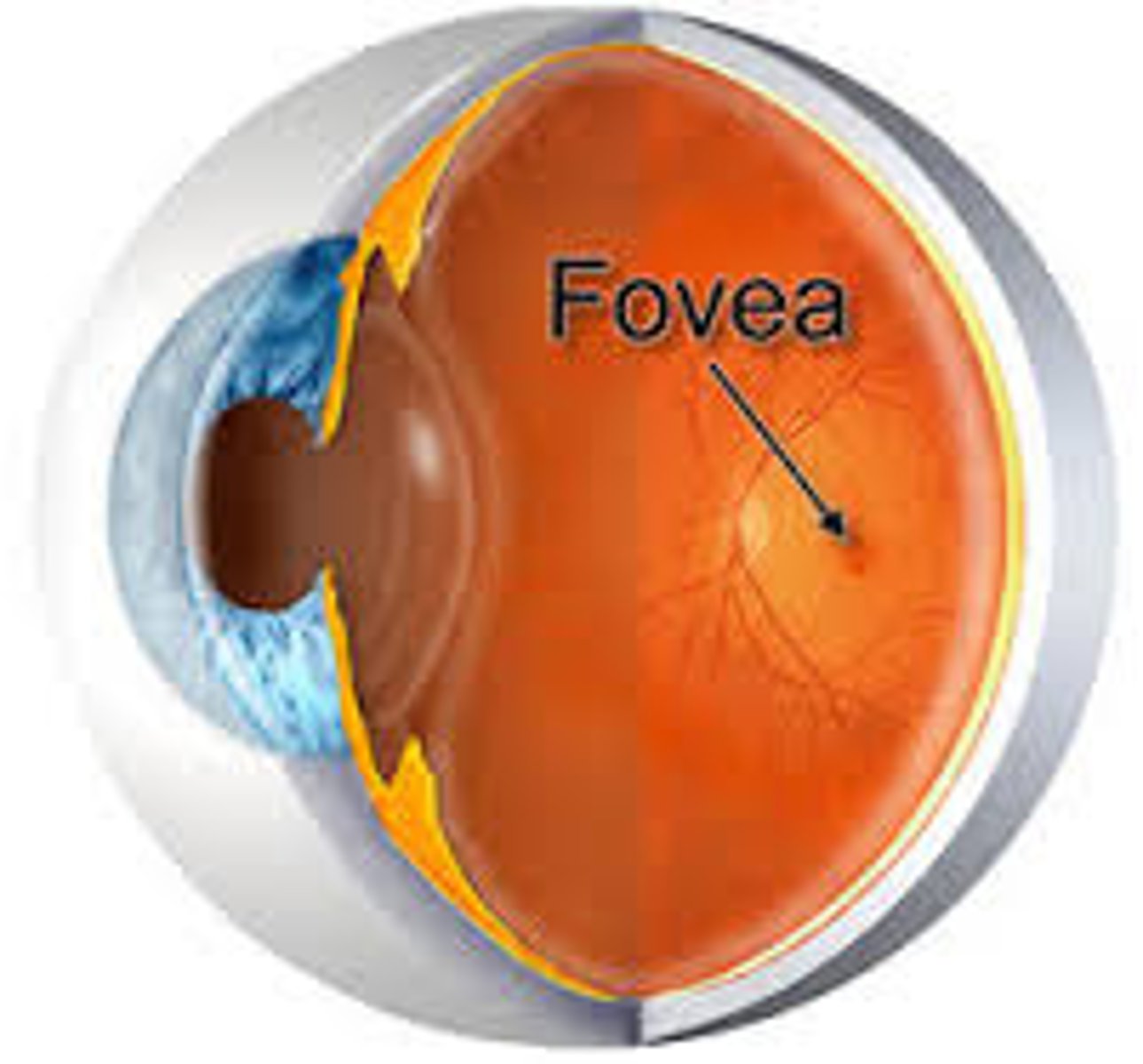
feature detectors
Specialized neurons in the brain that respond to specific features of the stimulus. In the occipital lobe's visual cortex they respond to specific features of an image such as angles, lines, curves, & movement. The cortical cells (neurons) respond most strongly to visual stimuli.
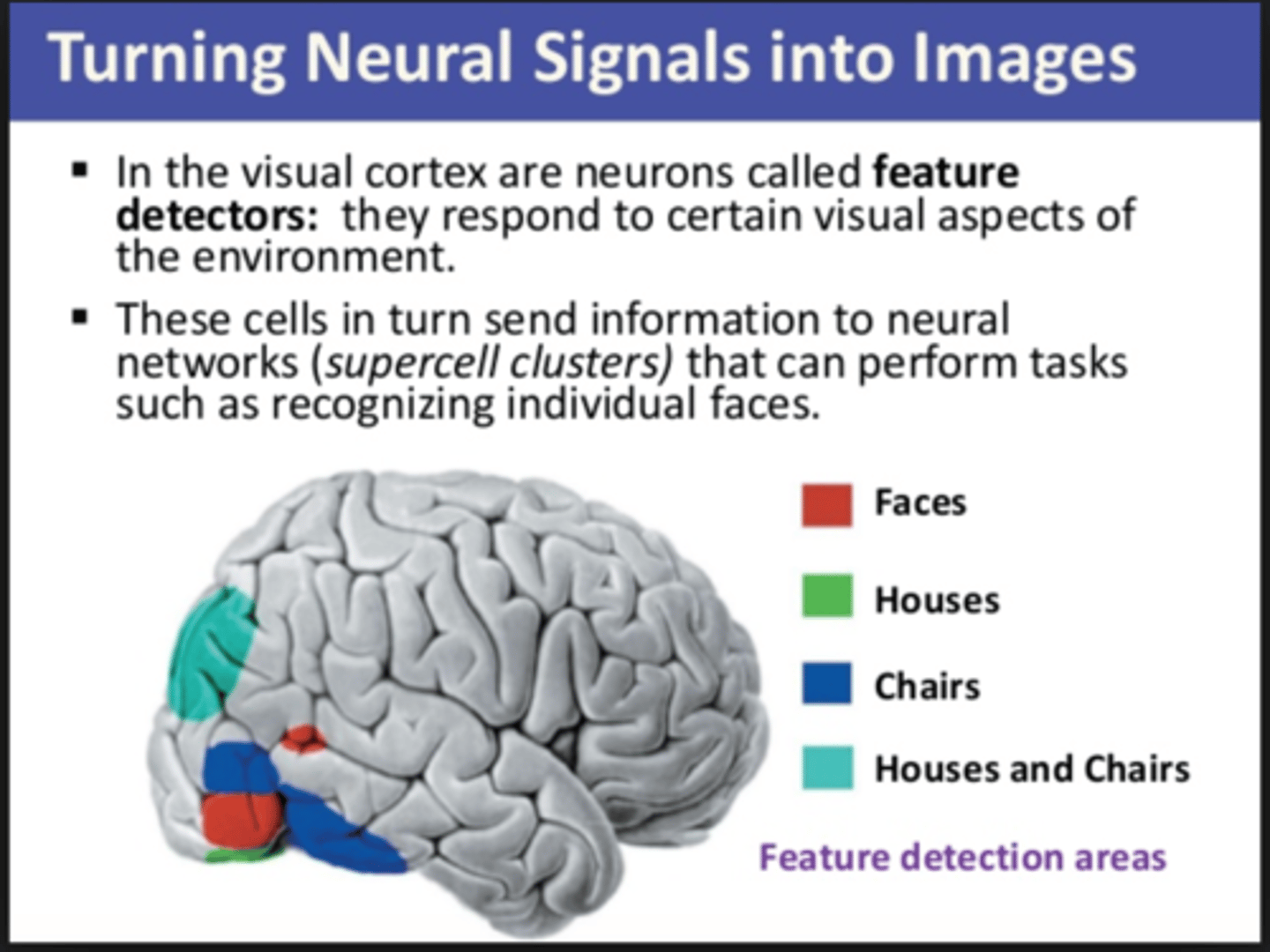
parallel processing
The ability of the brain to simultaneously process incoming stimuli of differing quality. Parallel processing is a part of vision in that the brain divides what it sees into four components: color, motion, shape, and depth.
Young-Helmholtz trichromatic (three-color)
The theory that the retina contains three different color receptors—one most sensitive to red, one to green, one to blue—which, when stimulated in combination, can produce the perception of any color.
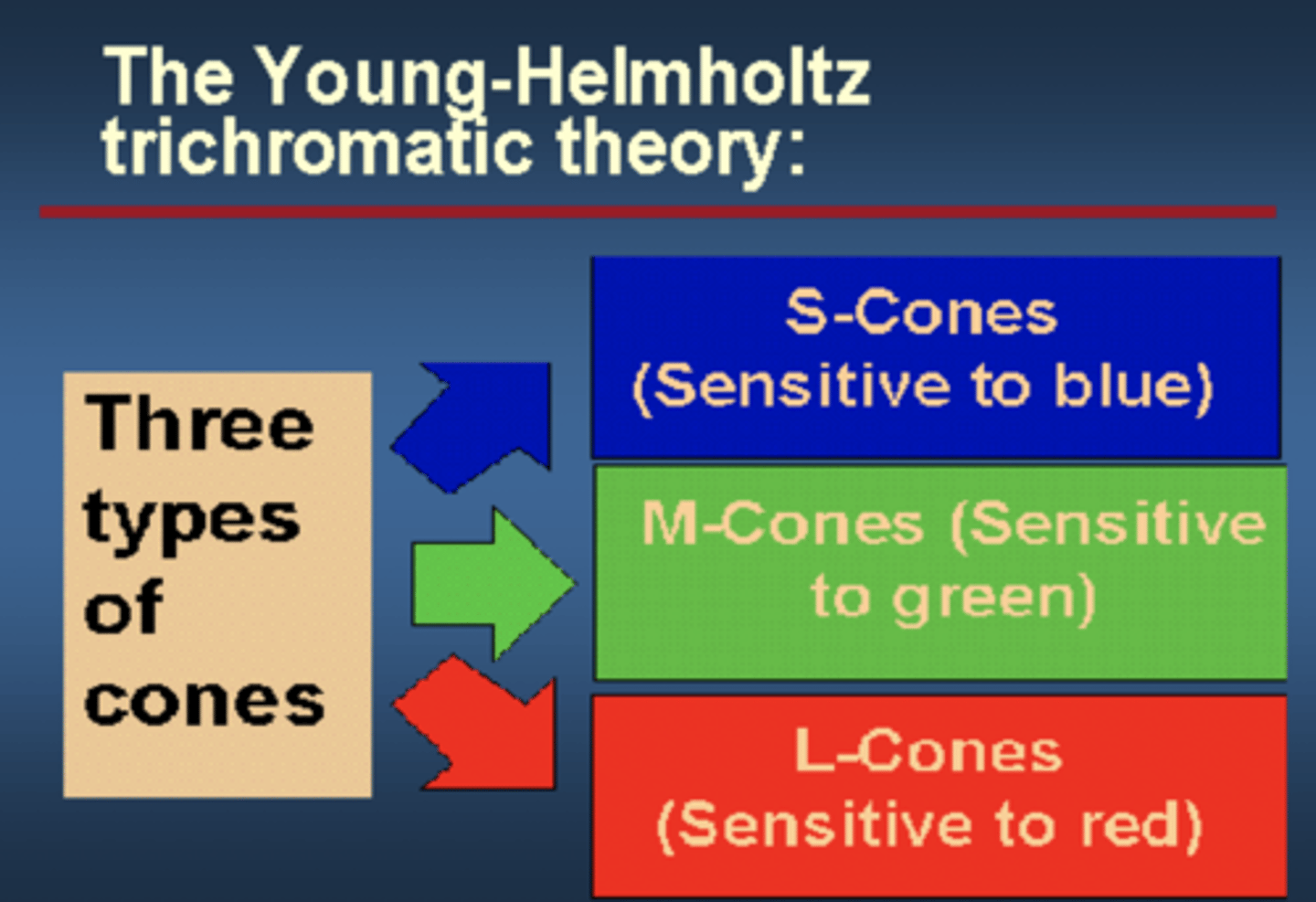
opponent-process theory
the theory that opposing retinal processes (red-green, yellow-blue, white-black) enable color vision. These cells can only detect the presence of one color at a time because the two colors oppose one another. Reason for seeing negative afterimages.

gestalt theory principles
Our tendency to integrate pieces of information into meaningful wholes. Six individual principles: similarity, continuation, closure, proximity, figure/ground, and symmetry. (Gestalt psychologists Wertheimer, Kohler & Koffka)

figure-ground
A Gestalt principle of the organization of the visual field into objects (the figures) that stand out from their surroundings (the ground). (Could also apply to sound)
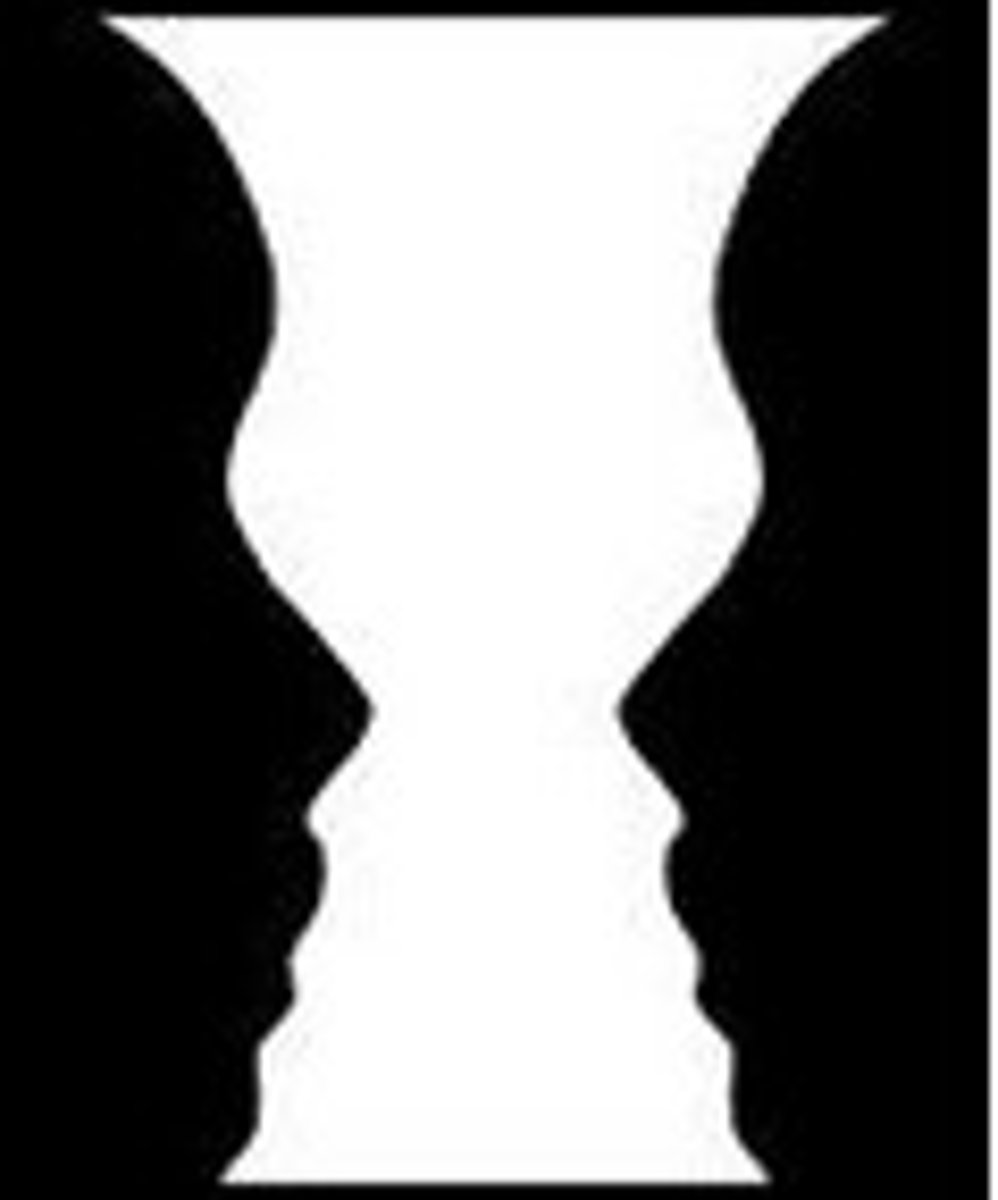
depth perception
Visual ability to perceive the world in three dimensions, coupled with the ability to gauge how far away an object is. Depth perception, size, and distance are ascertained through both monocular (one eye) and binocular (two eyes) cues. Monocular vision is poor at determining depth.
visual cliff
Eleanor Gibson lab for testing depth perception in infants. The floor below has the same pattern as the opaque surface. Indicates some depth perception is innate.
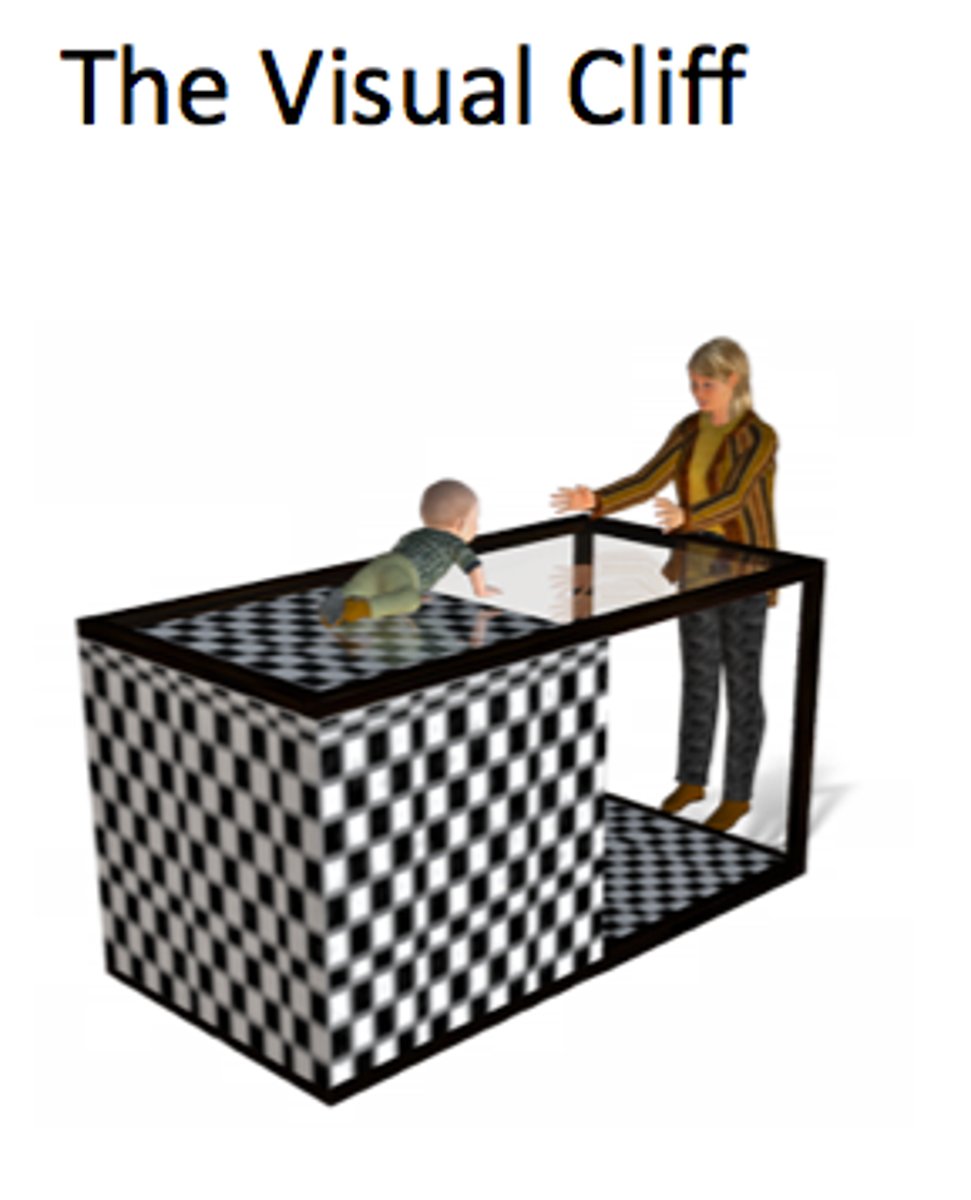
binocular cues
Depth cues, such as retinal disparity and convergence, that depend on the use of two eyes.
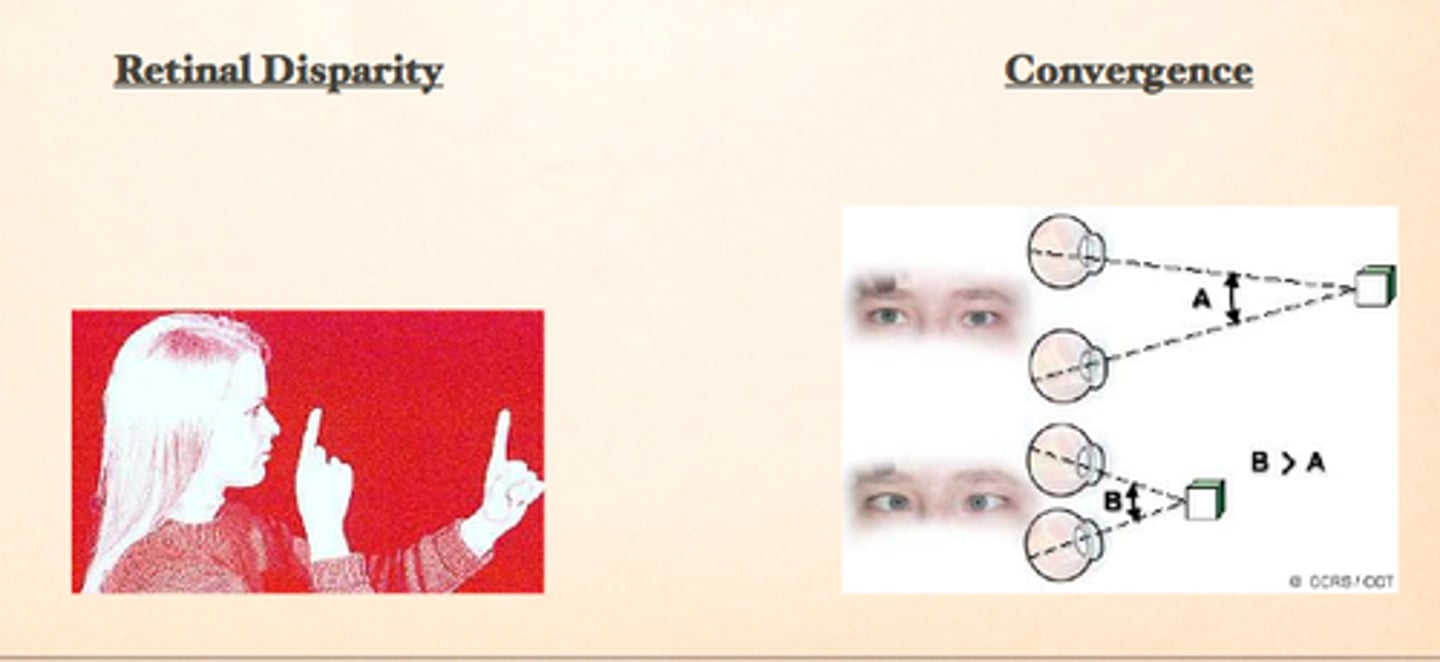
retinal disparity
A binocular cue for perceiving depth: By comparing images from the retinas in the two eyes, the brain computes distance—the greater the disparity (difference) between the two images, the closer the object.
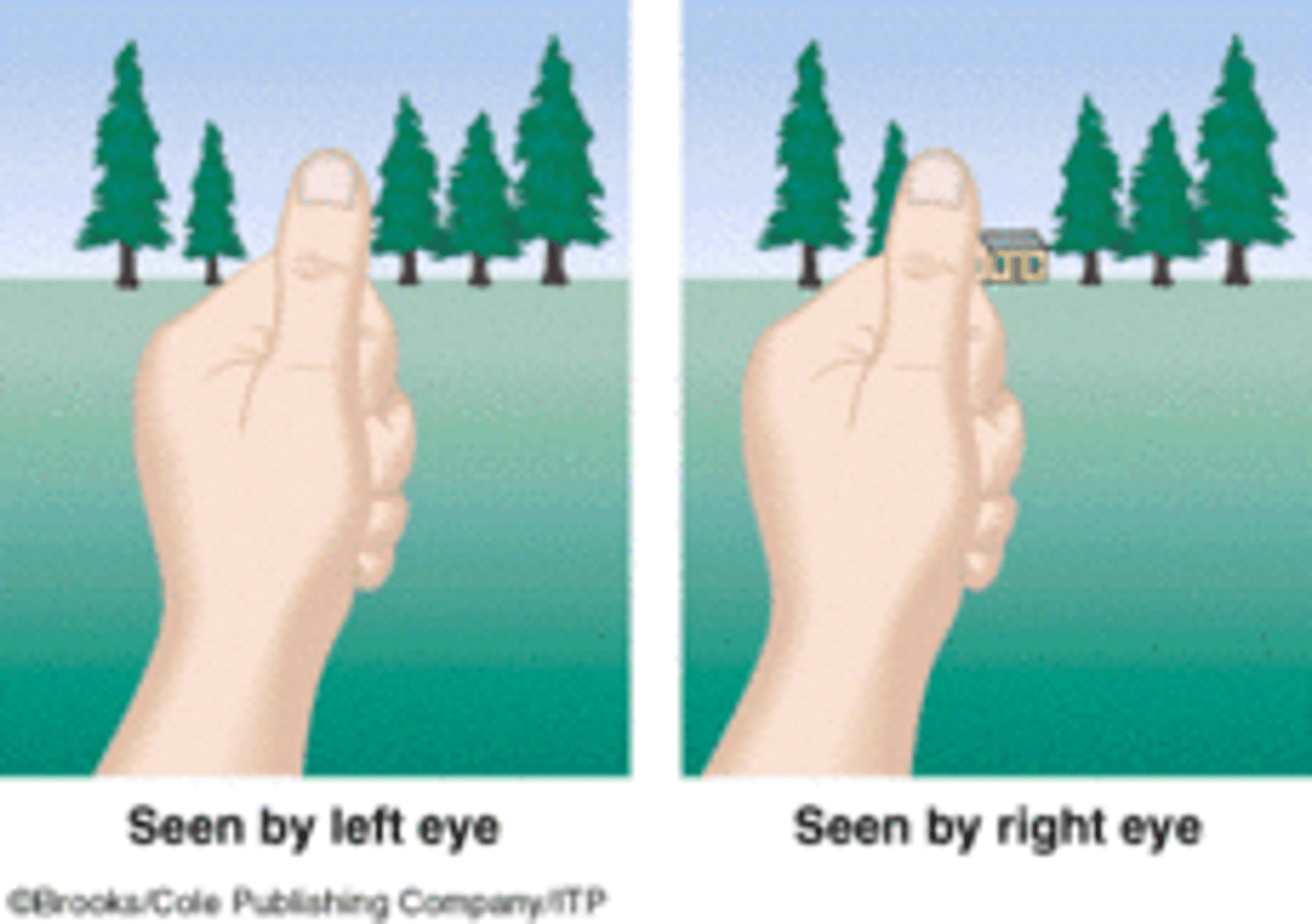
monocular cues
Depth cues, such as interposition and linear perspective, available to either eye alone.
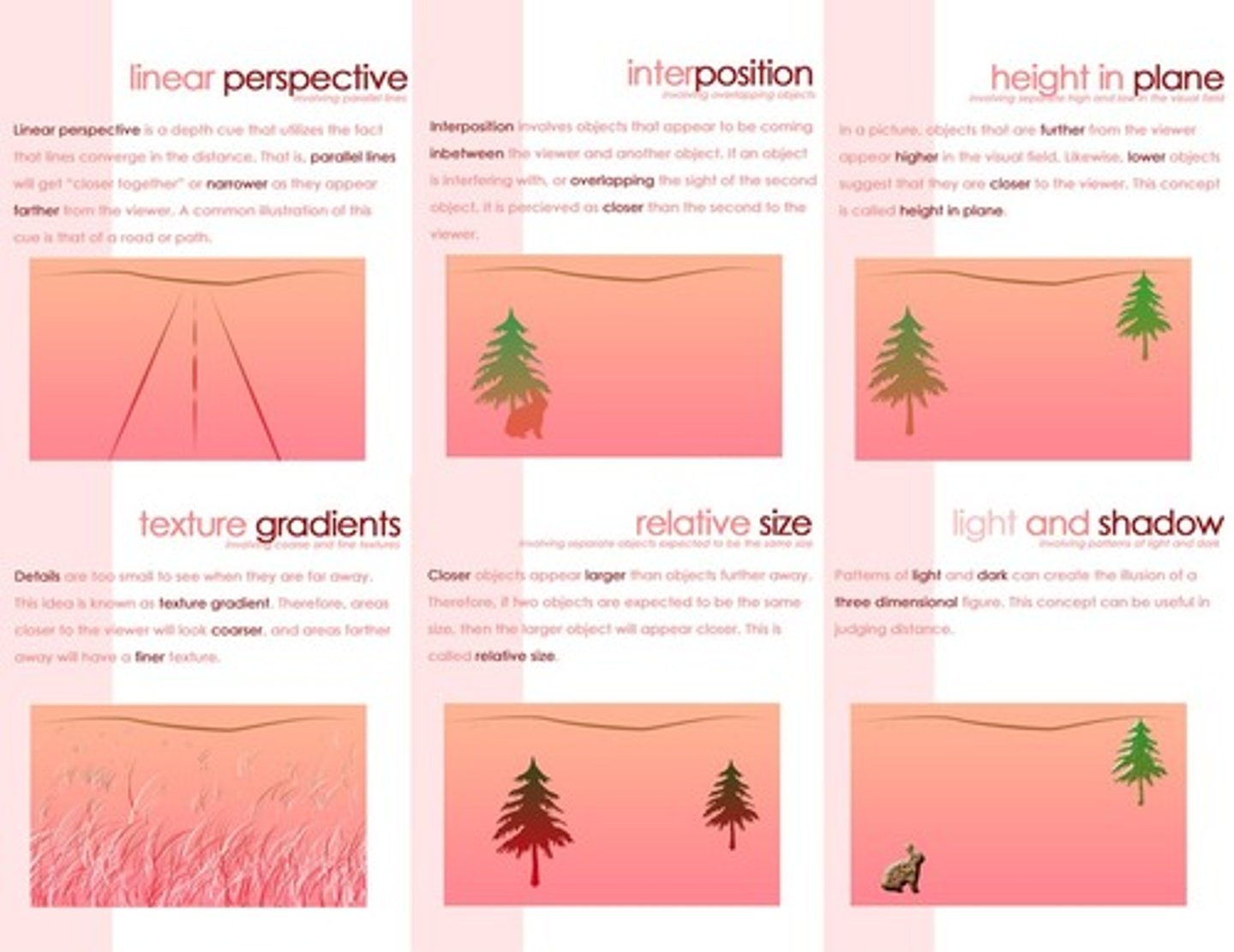
phi phenomenon
An illusion of movement created when two or more adjacent lights blink on and off in quick succession.
perceptual constancy
Perceiving objects as unchanging (having consistent shapes, size, brightness, and color) even as illumination and retinal images change. ("shape constancy", "size constancy", "color constancy")
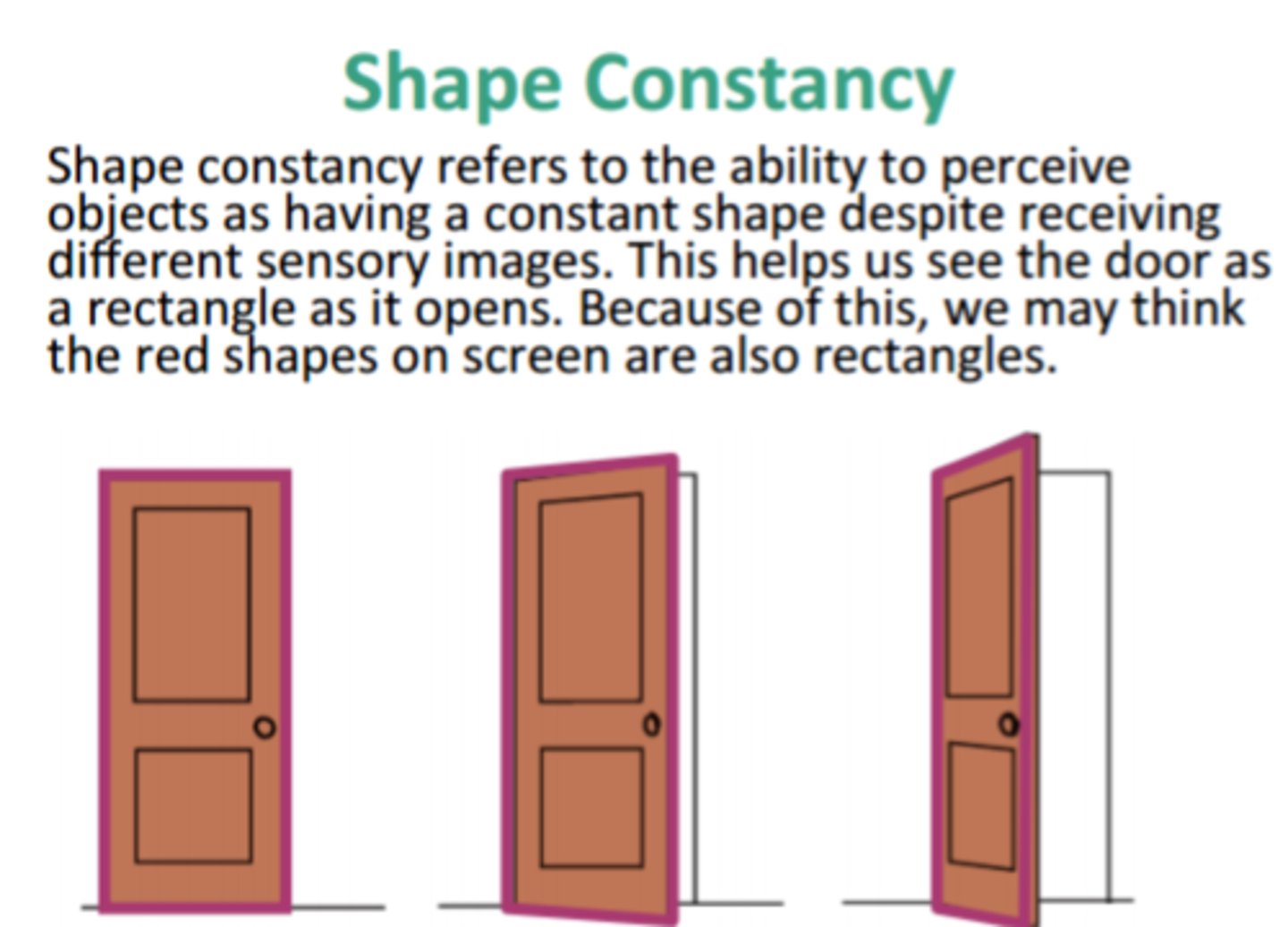
color constancy
Perceiving familiar objects as having consistent color, even if changing illumination alters the wavelengths reflected by the object.
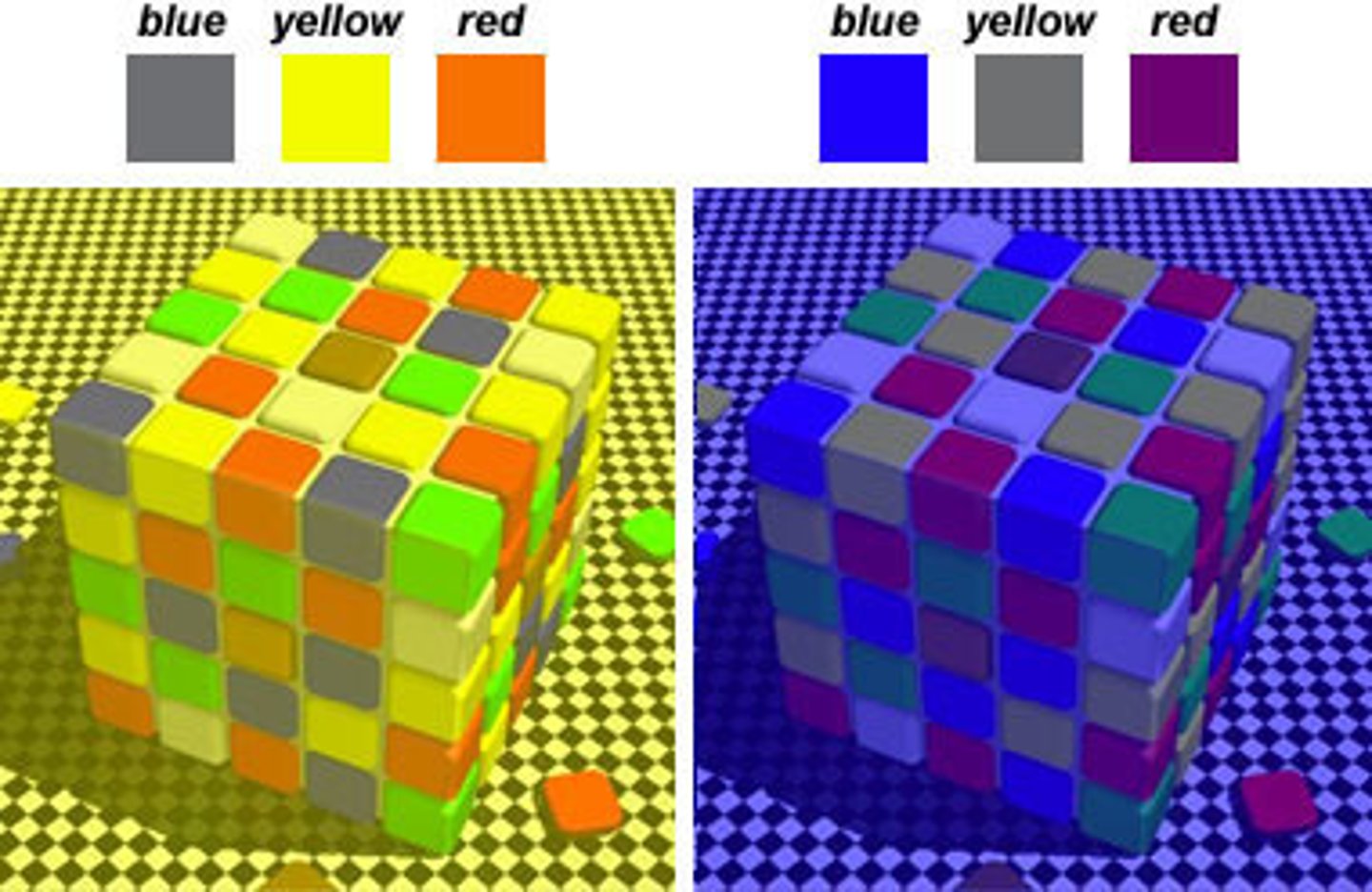
pitch
A tone's experienced highness or lowness; depends on frequency. Refers to a sound's place on the frequency scale of human hearing.
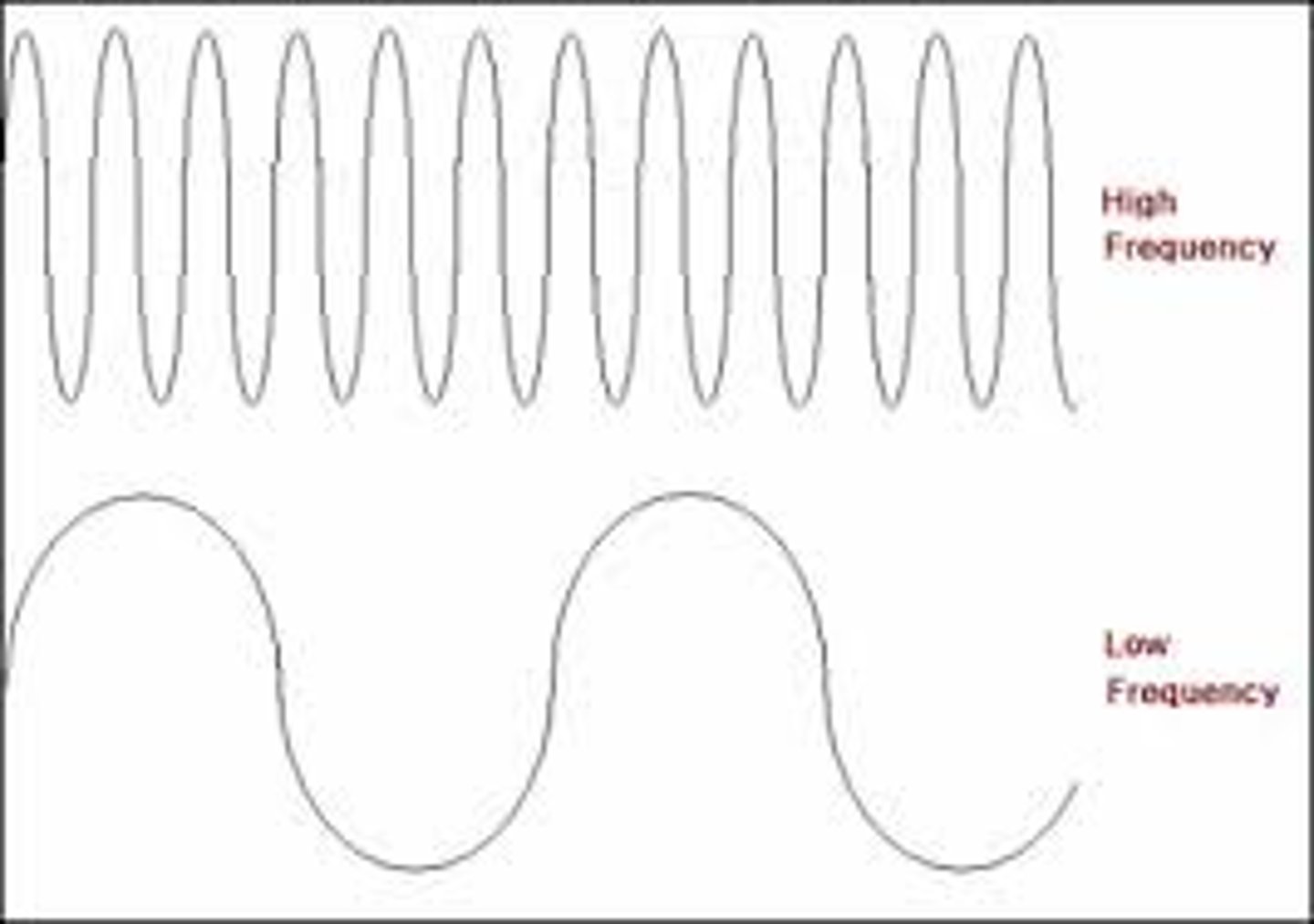
middle ear
The chamber between the eardrum and cochlea containing three tiny bones (hammer, anvil, and stirrup) that concentrate the vibrations of the eardrum on the cochlea's oval window. It transfers sound information from the tympanic membrane to the oval window.
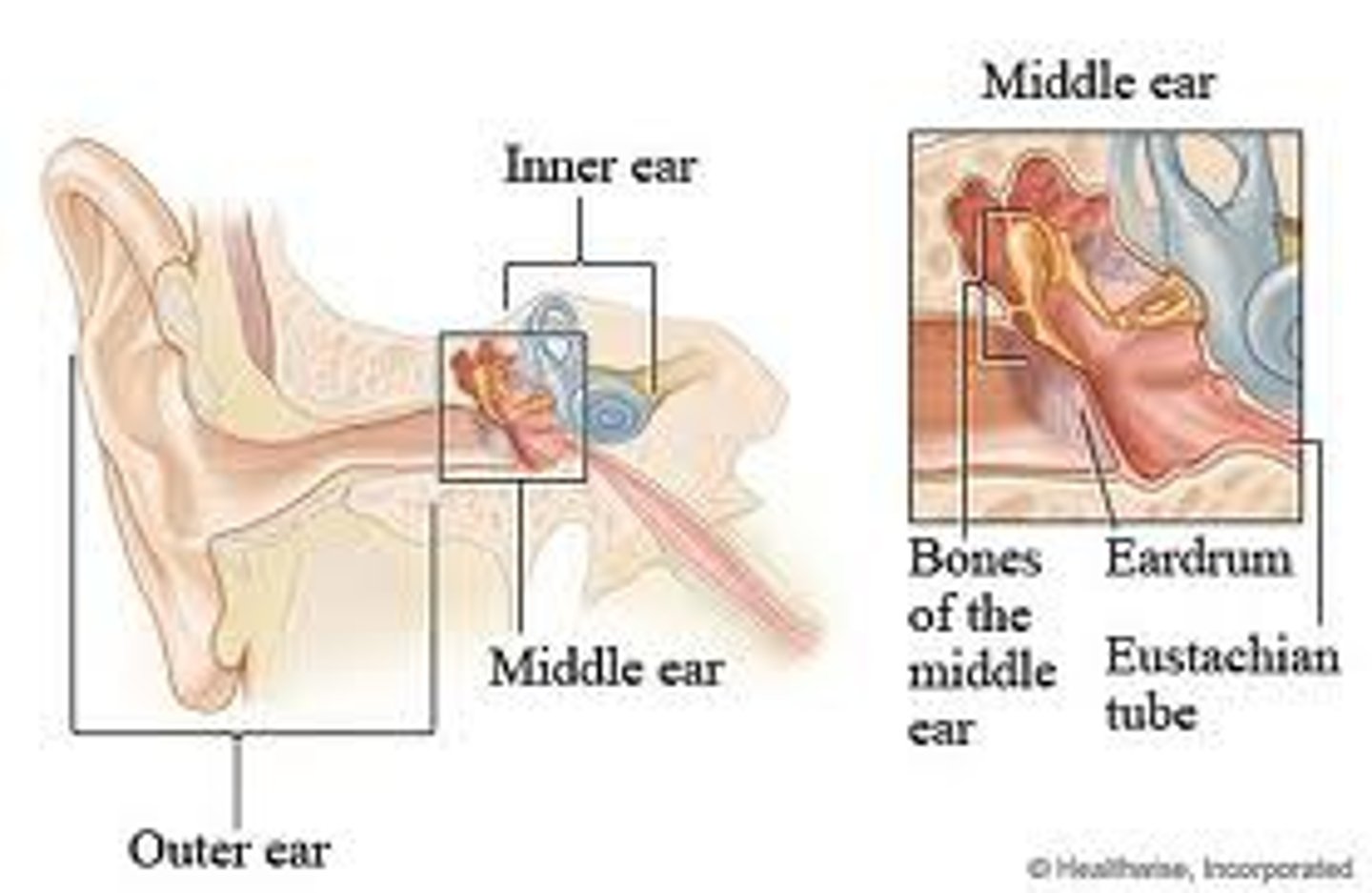
cochlea
A coiled, bony, fluid-filled tube in the inner ear; and inside the cochlea are hair cells which are auditory receptors for hearing.
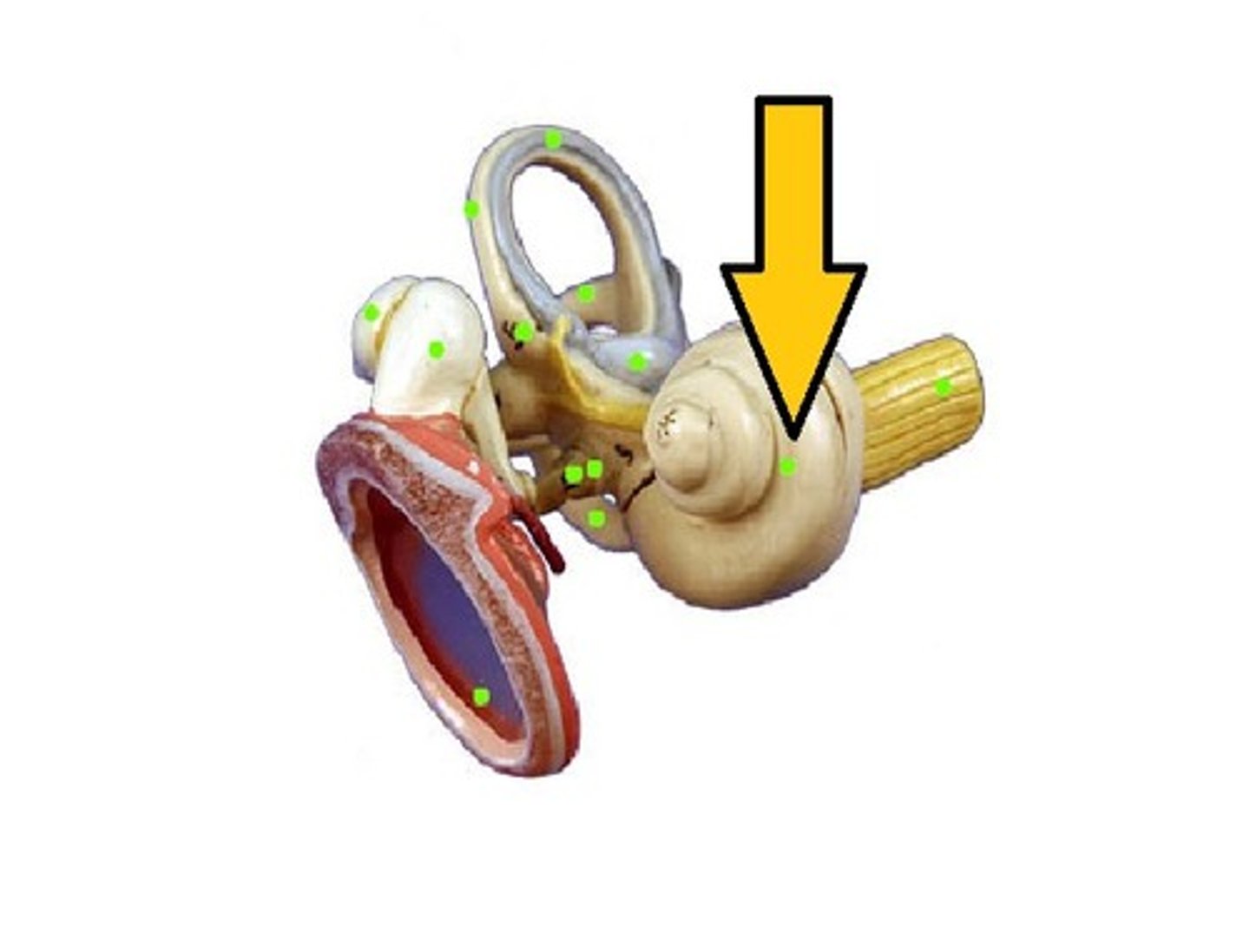
inner ear
The innermost part of the ear, containing the cochlea, semicircular canals, and vestibular sacs. The hair receptors found in the inner ear are important for balance.
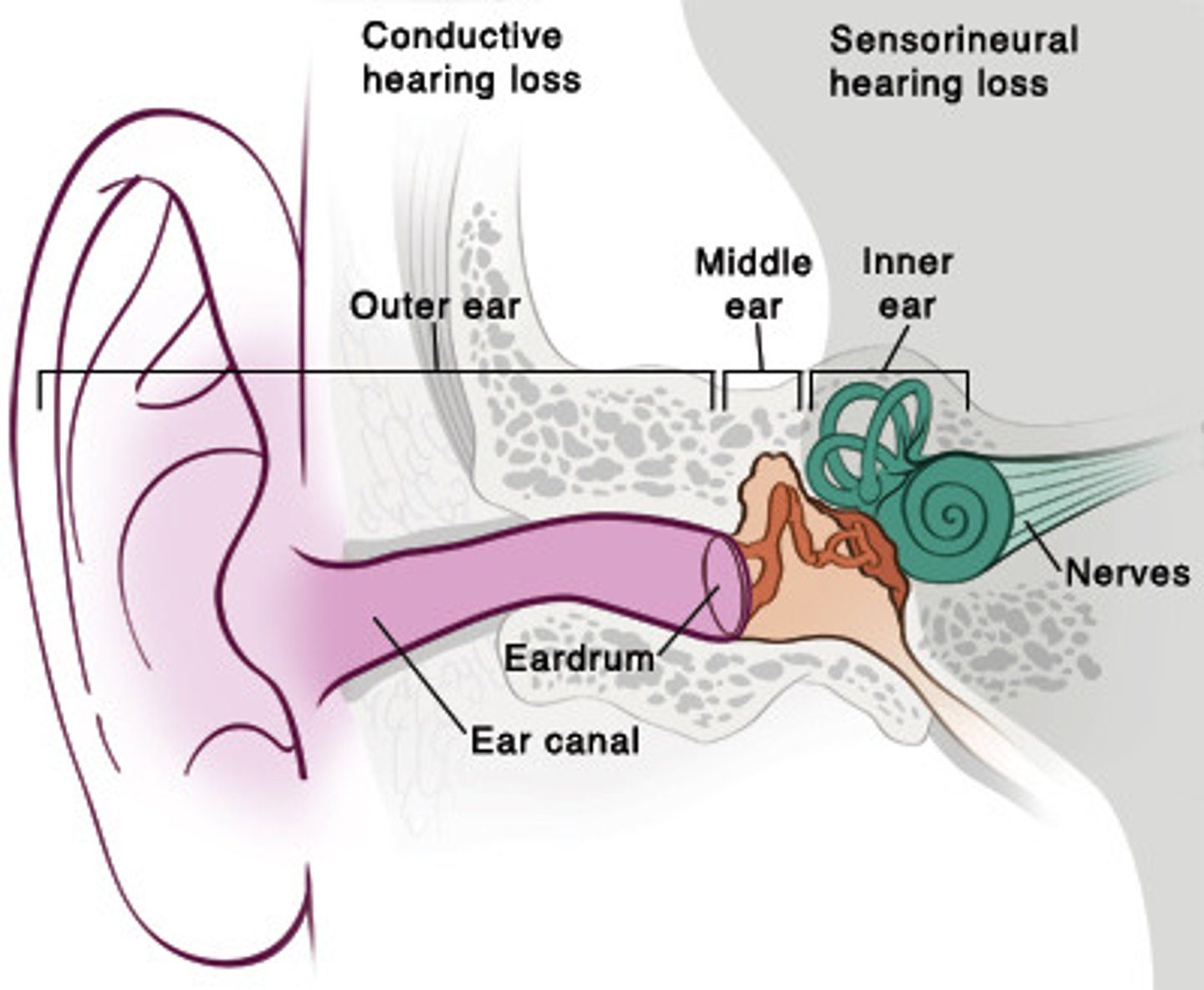
sensorineural hearing loss
hearing loss caused by damage to the cochlea's receptor cells or to the auditory nerves. (Also called nerve deafness.)
conduction deafness
Caused by damage to the system that conducts sound waves to the cochlea. This may be damage done to the eardrum or the middle ear bones (anvil, hammer, stirrup).
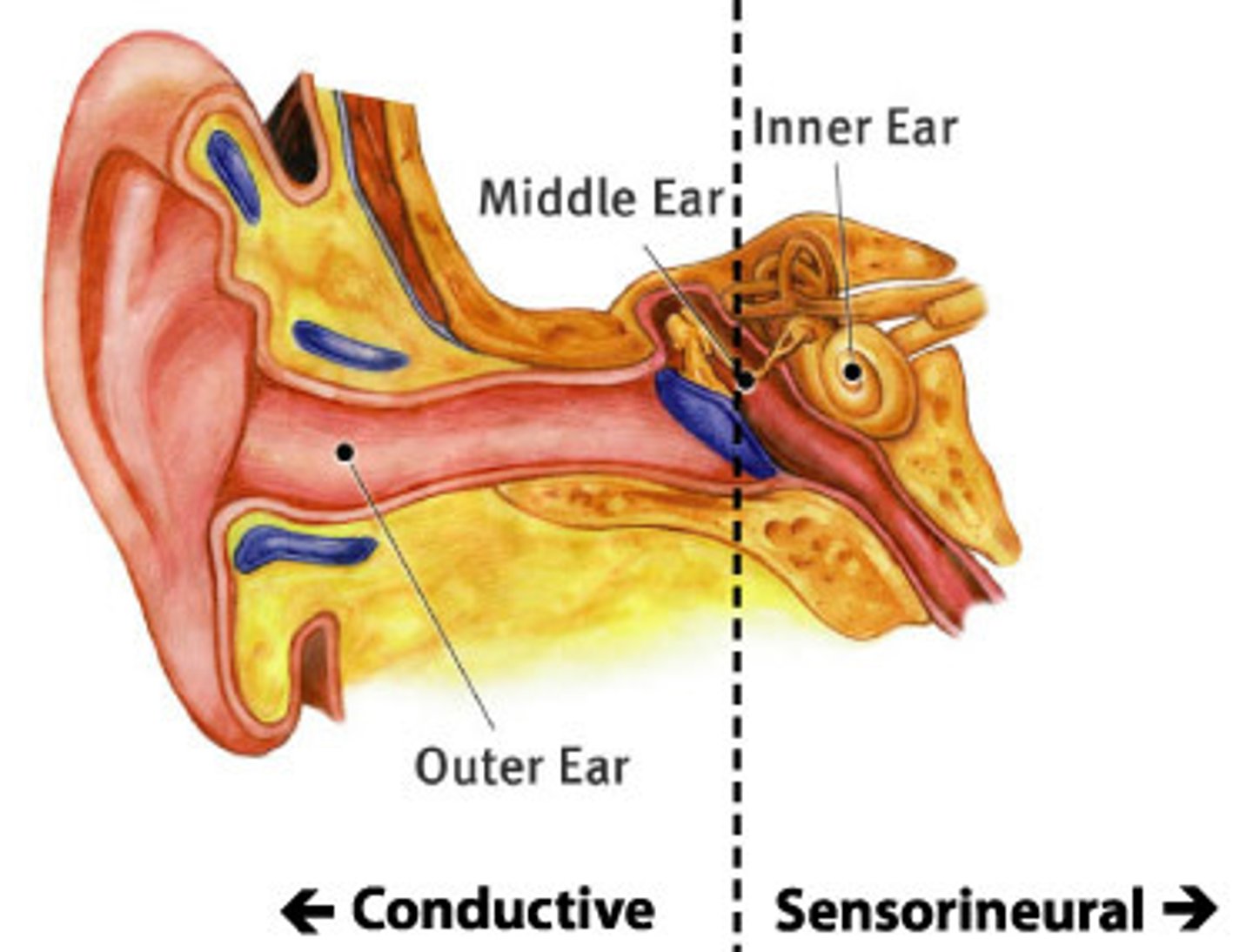
place theory
The theory that the pitch we hear is due to the PLACE where the cochlea's membrane is stimulated. Our perception of sound depends on where each component frequency produces vibrations along the basilar membrane within the cochlea of the inner ear. (explains high frequencies)
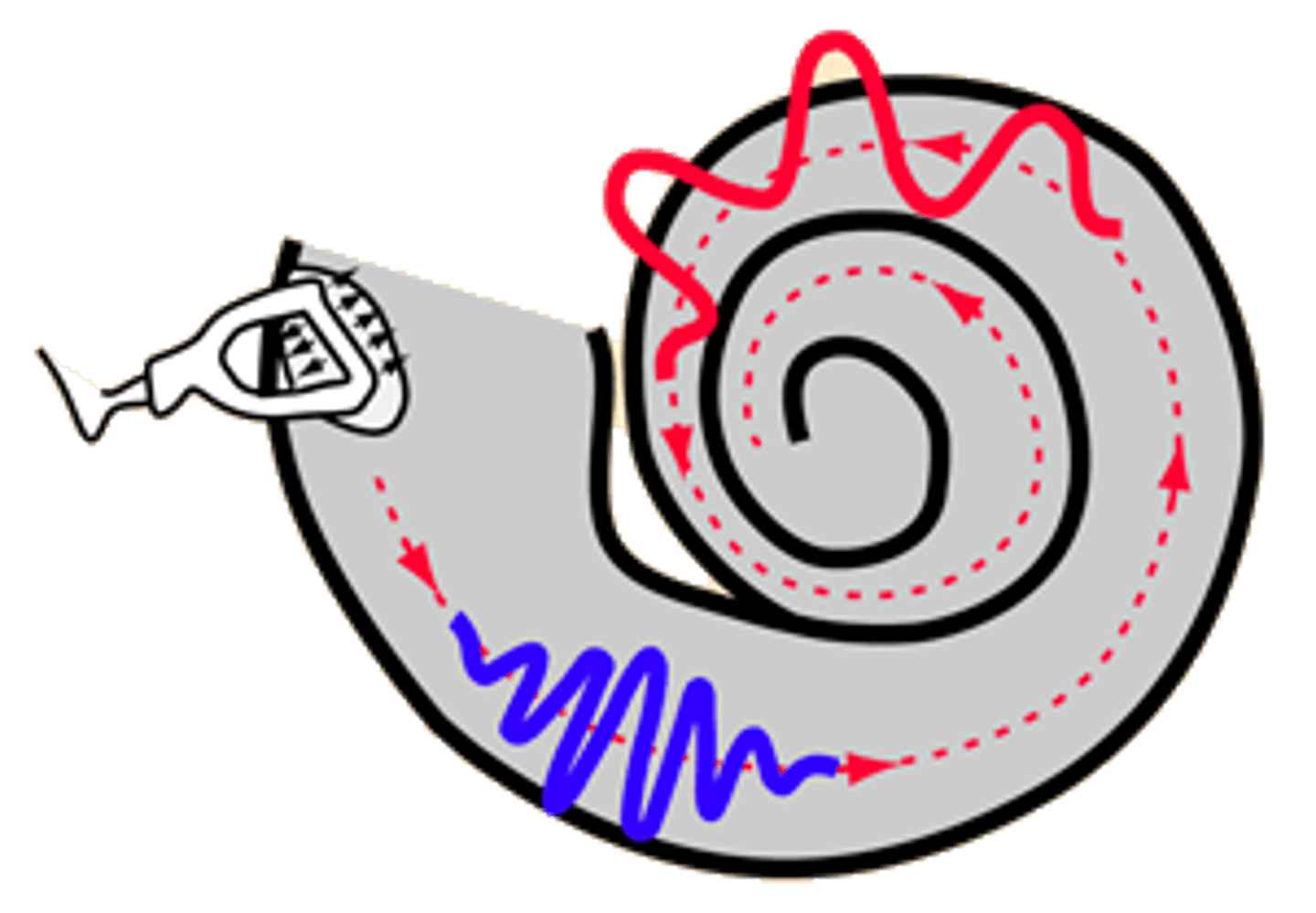
frequency theory
Theory that sounds are pulses that travel up the auditory nerve, to the brain for processing, and that the pitch of a tone is determined by how quickly the sound wave is making the air vibrate (frequency) and has almost nothing to do with the intensity, or amplitude, of the wave. That is, "high" pitch means very rapid oscillation, and "low" pitch corresponds to slower oscillation. The rate of this pulse matches the frequency of whatever tone you are hearing exactly. (explains low frequencies)
gate-control theory
Theory that the spinal cord contains a neurological "gate" that blocks pain signals or allows them to pass on to the brain. The "gate" is opened by the activity of pain signals traveling up small nerve fibers and is closed by activity in larger fibers or by information coming from the brain. (ex. bang your knee so rub it so larger message is sent to brain to counteract knee pain message...large fibers fires inhibitory neurons so gate closes).
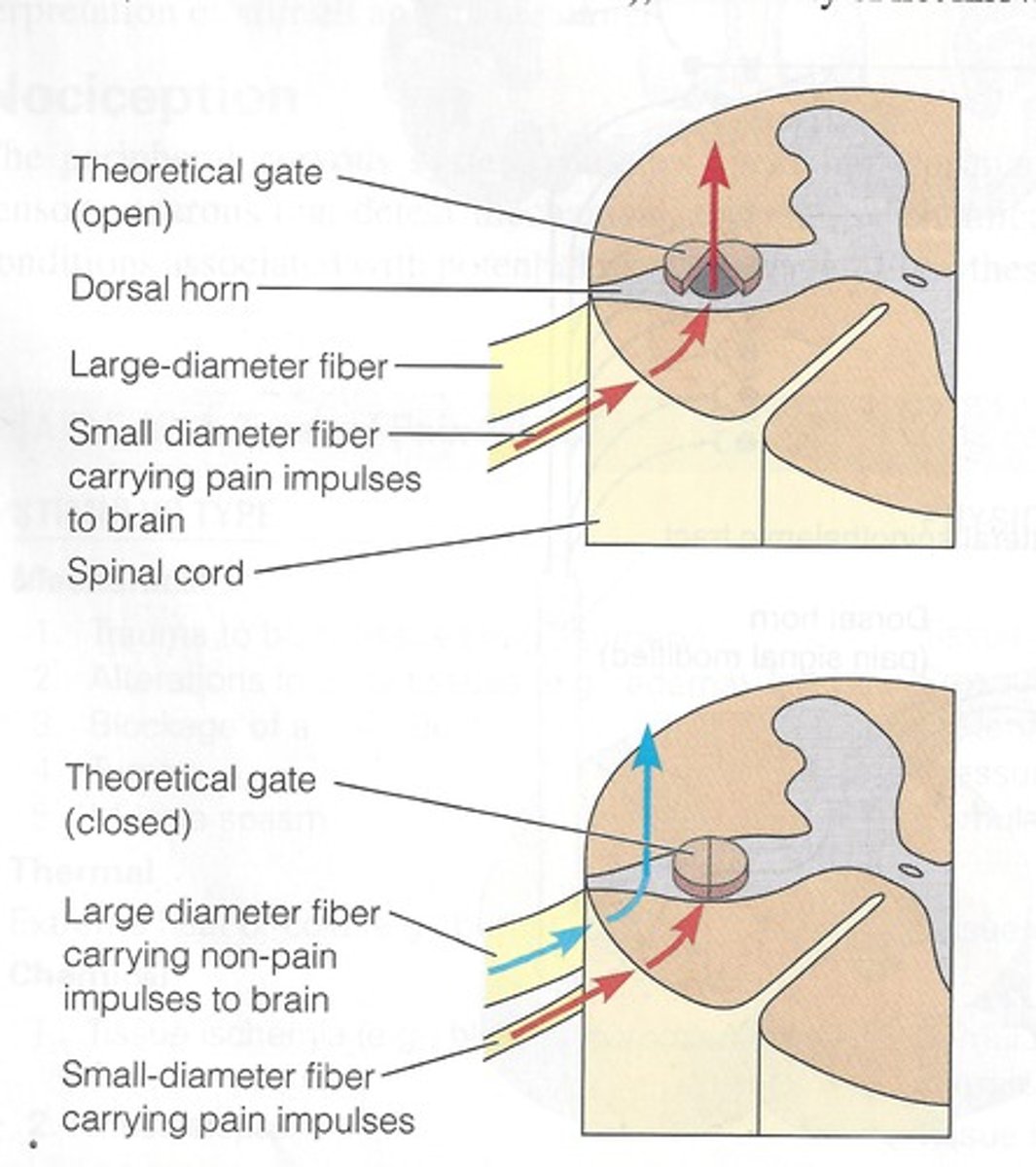
kinesthetic sense
The system for sensing the position and movement of individual body parts involves the cerebellum.
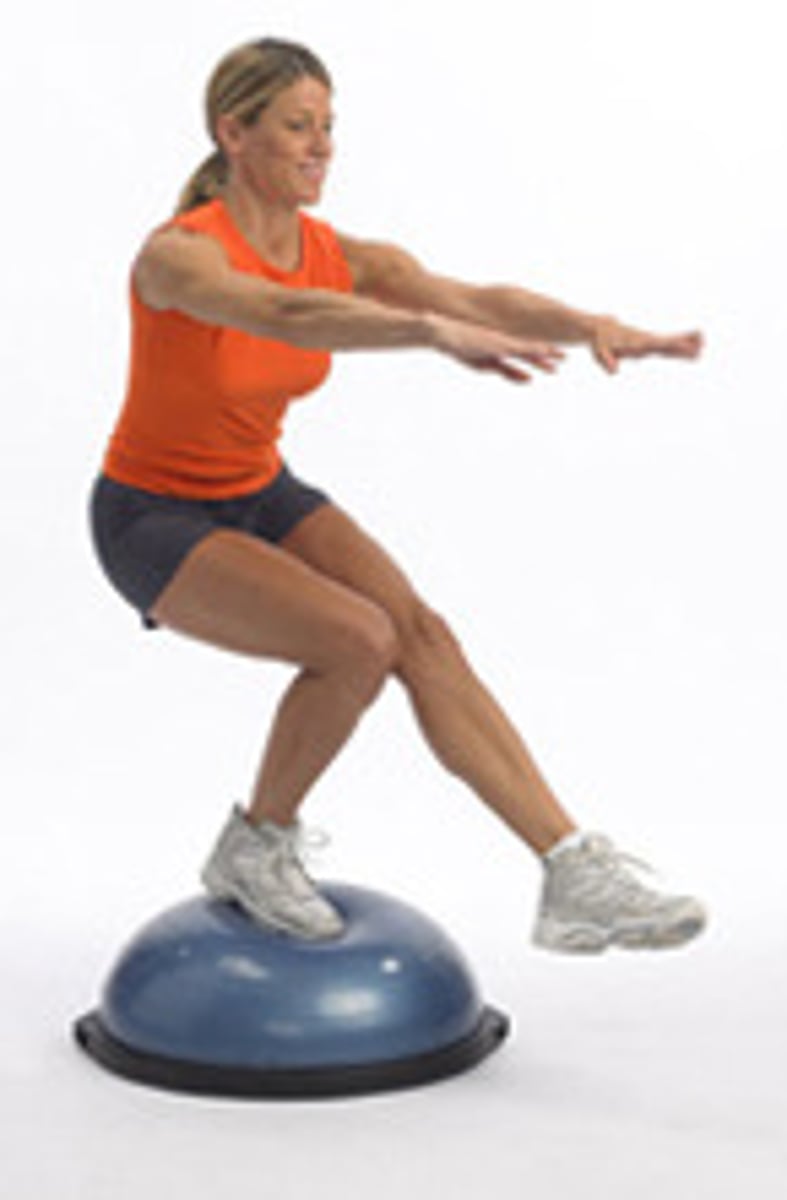
vestibular sense
Inside the inner ear and made up of three semicircular canals that have hair-like receptors in it that are sensitive to different types of movement. Information about these movements is sent to the cerebellum, which co-ordinates the motor movements needed to maintain posture and balance.
sensory interaction
The principle that one sense may influence another, as when the smell of food influences its taste.

bipolar cells
A type of retinal cells that neural signals from the photoreceptors (rods & cones) and passes them to the ganglion cells (sending visual info to the brain).
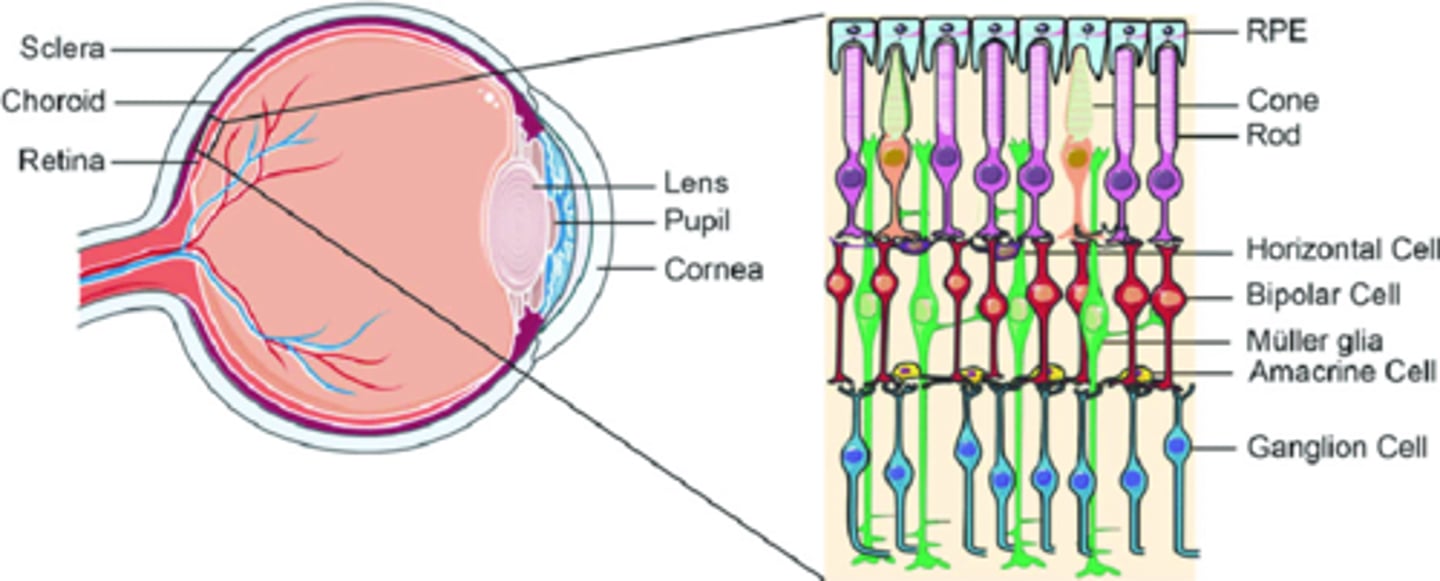
ganglion cells of the eye
In the retina, the specialized neurons that connect to the bipolar cells; forms the optic nerve that sends info to the brain.
basilar membrane
A structure that runs the length of the cochlea in the inner ear and holds the auditory receptors, called hair cells.
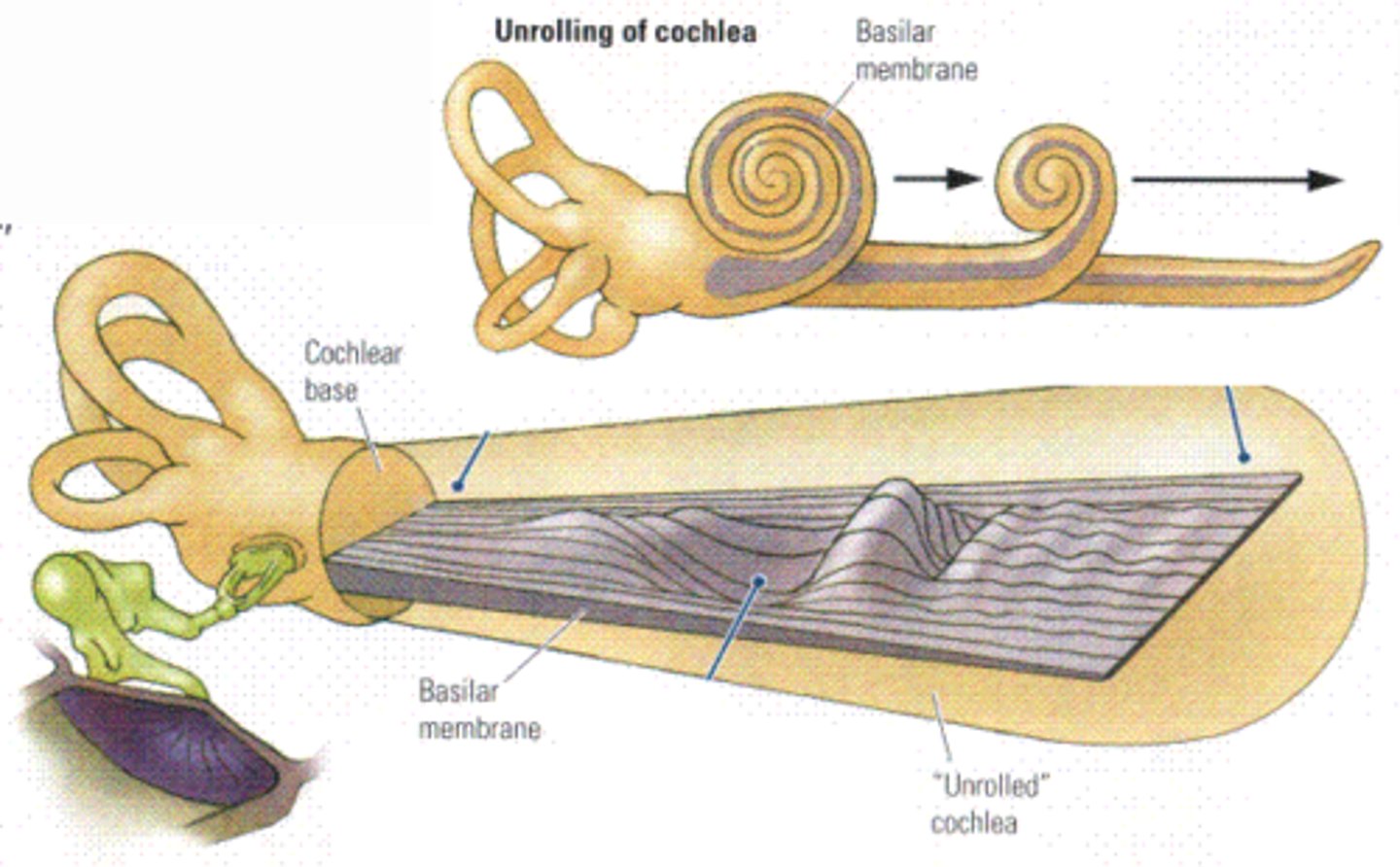
semicircular canal
In the inner ear and are responsible for our sense of balance. Three tiny, fluid-filled tubes. The liquid inside the canals moves the tiny hairs (cilia) that line each canal. (Could lead to dizziness or loss of balance)
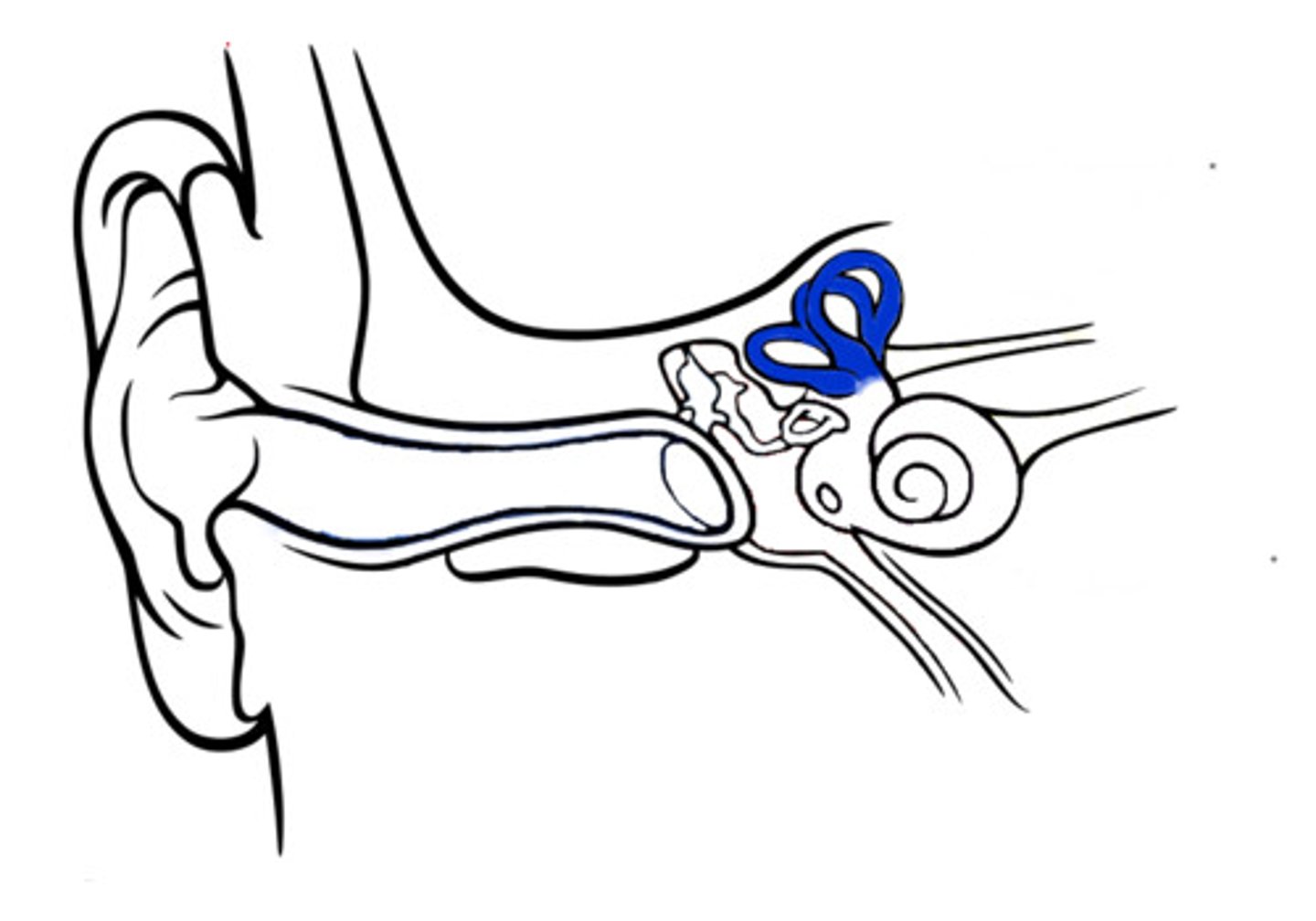
cocktail party effect
Phenomenon of the brain's ability to focus one's auditory attention on a particular stimulus while filtering out a range of other stimuli, such as when a partygoer can focus on a single conversation in a noisy room.
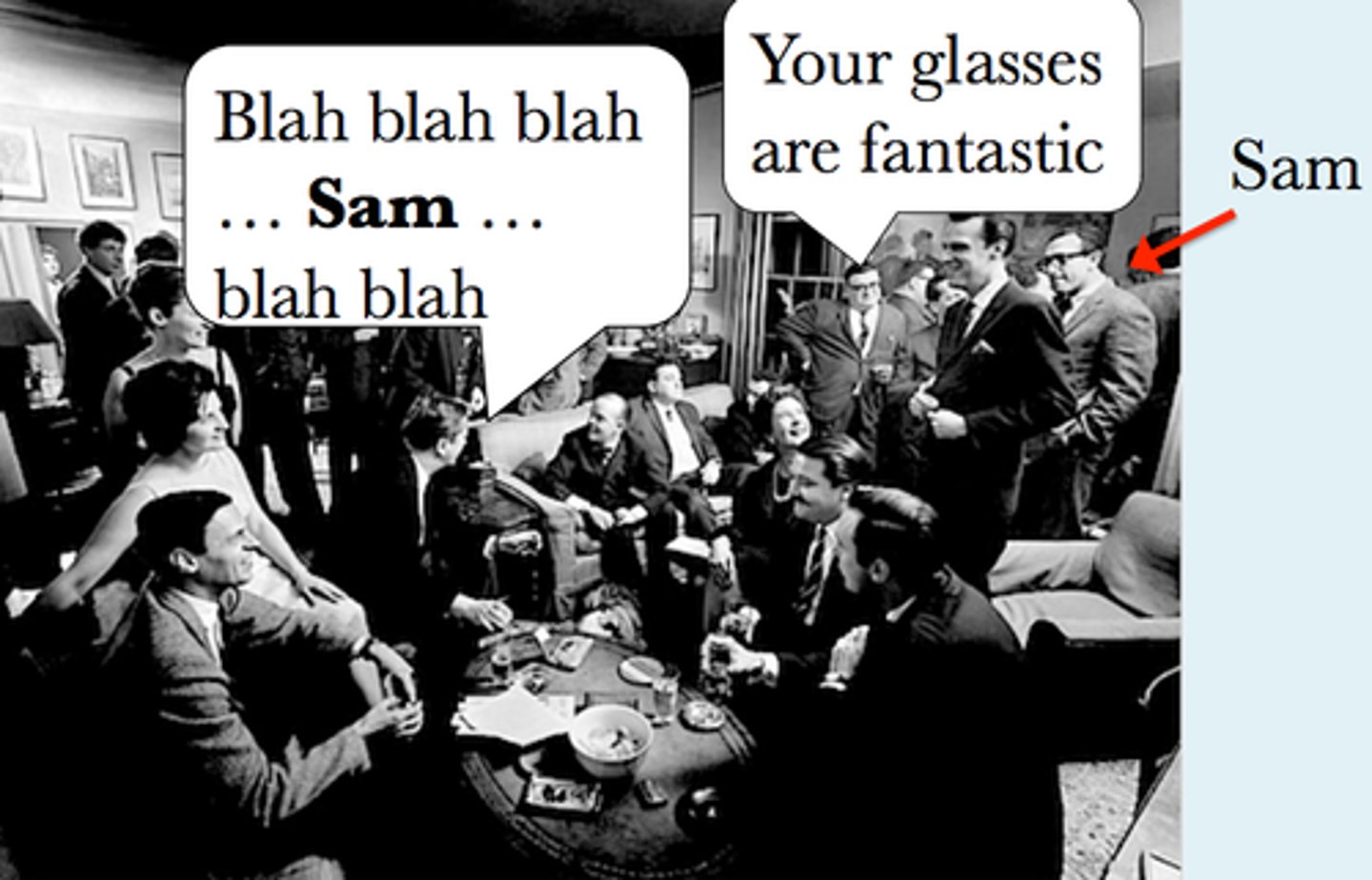
law of proximity
Elements located close to one another are perceived as belonging to the same figure. (Gestalt principle)

law of closure
The tendency to fill in the gaps in an incomplete image. (Gestalt principle)
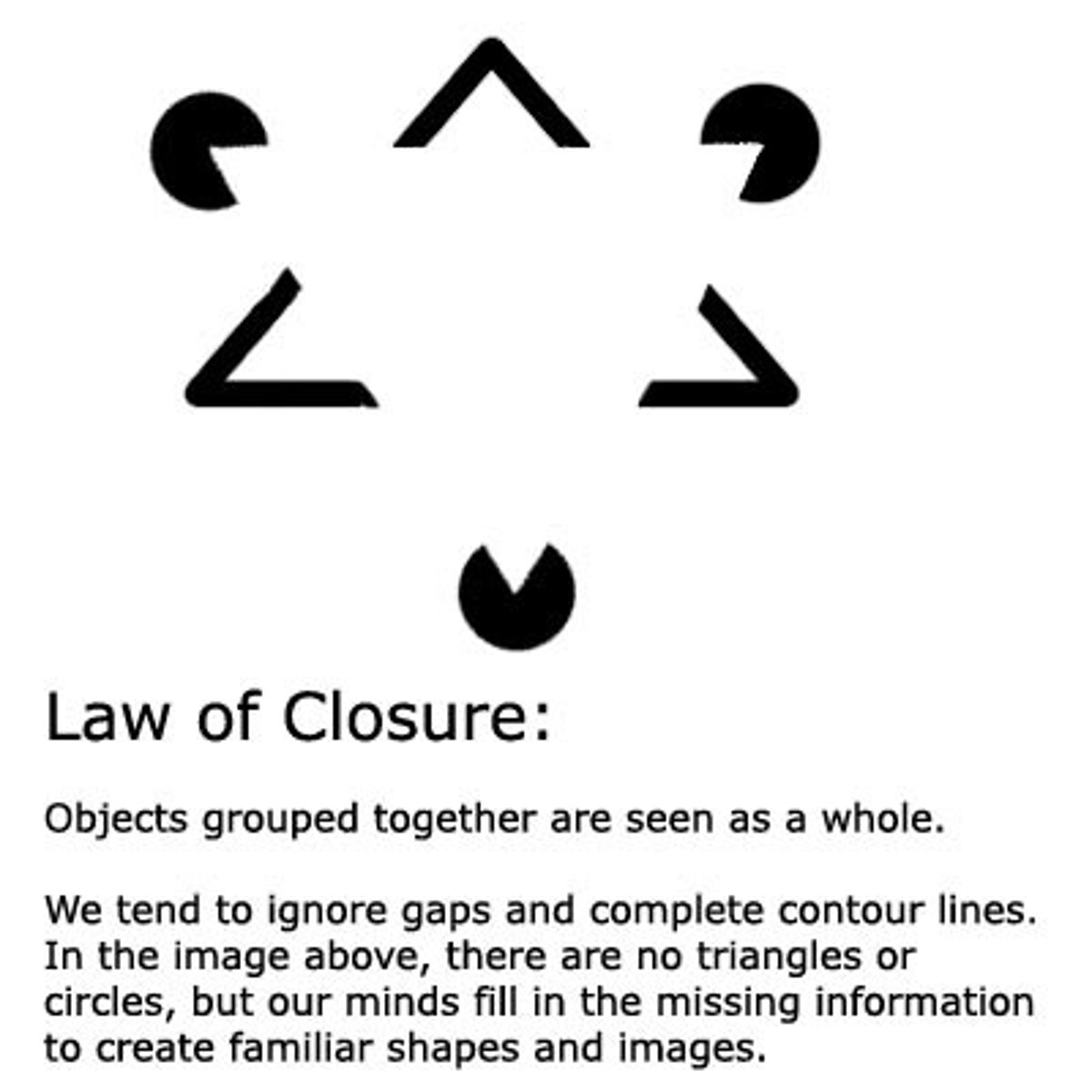
linear perspective
A monocular cue for perceiving depth; the more parallel lines converge, the greater their perceived distance.

relative size
The monocular cue that states that if an object seems larger, it is probably closer, and if an object is smaller, it is probably distant.
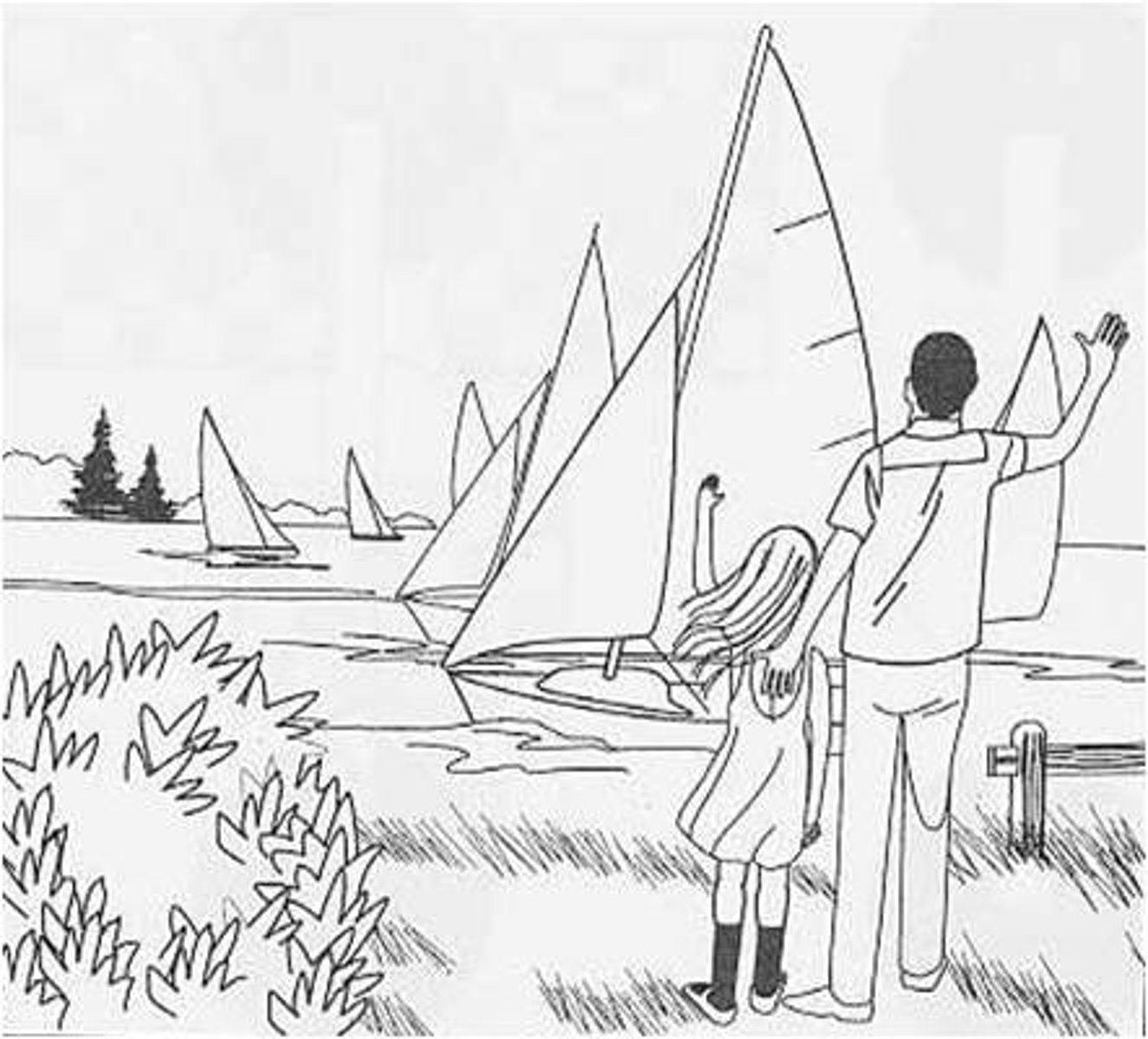
motion parallax (relative motion)
A depth cue whereby a difference in the apparent rate of movement of different objects provides information about the relative distance of those objects. Objects near seem to move faster than objects farther away which seem to move slower.
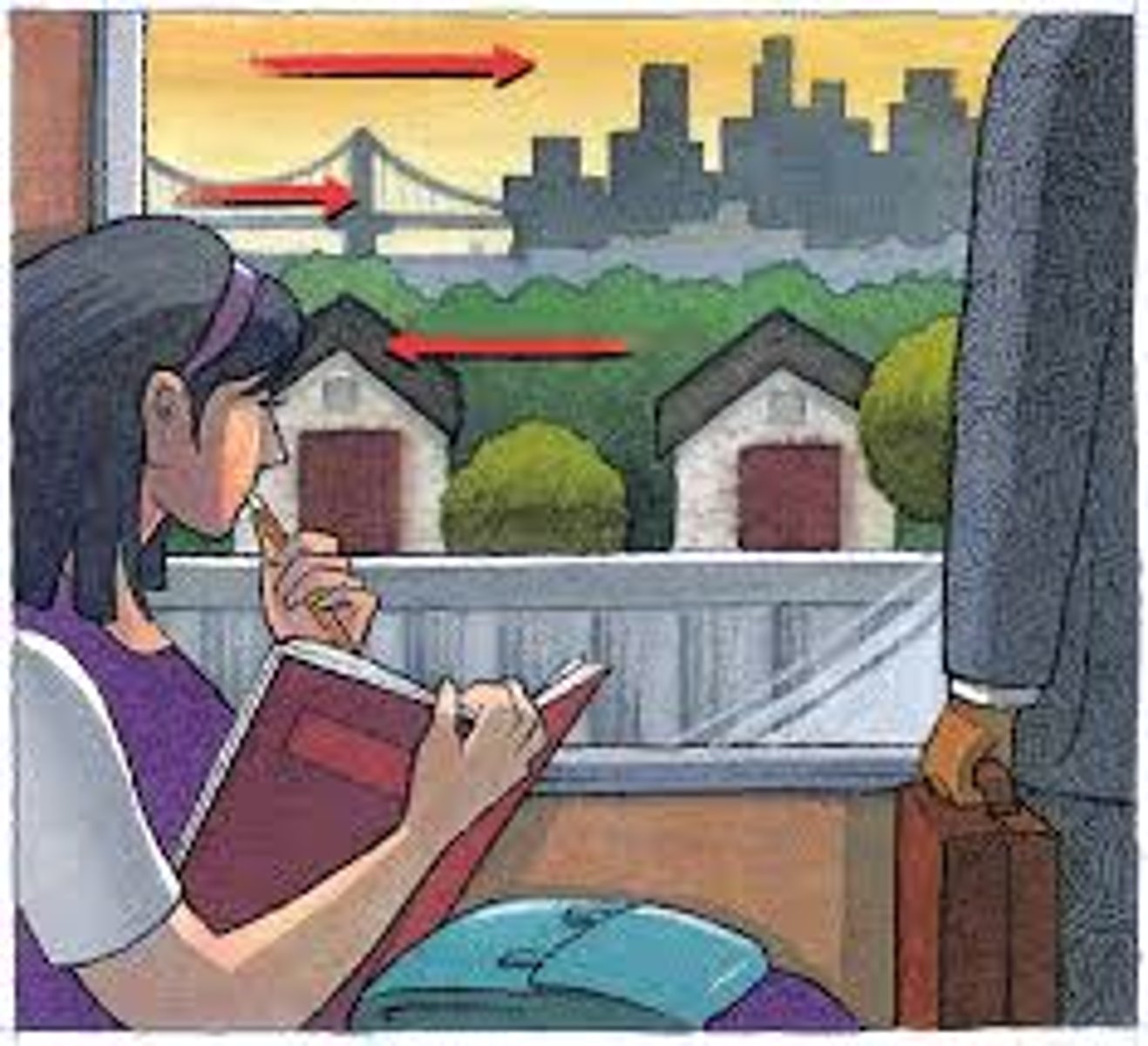
sound localization
We can locate sounds based on which ear they strike first. Sound will be detected by one ear earlier than the other.
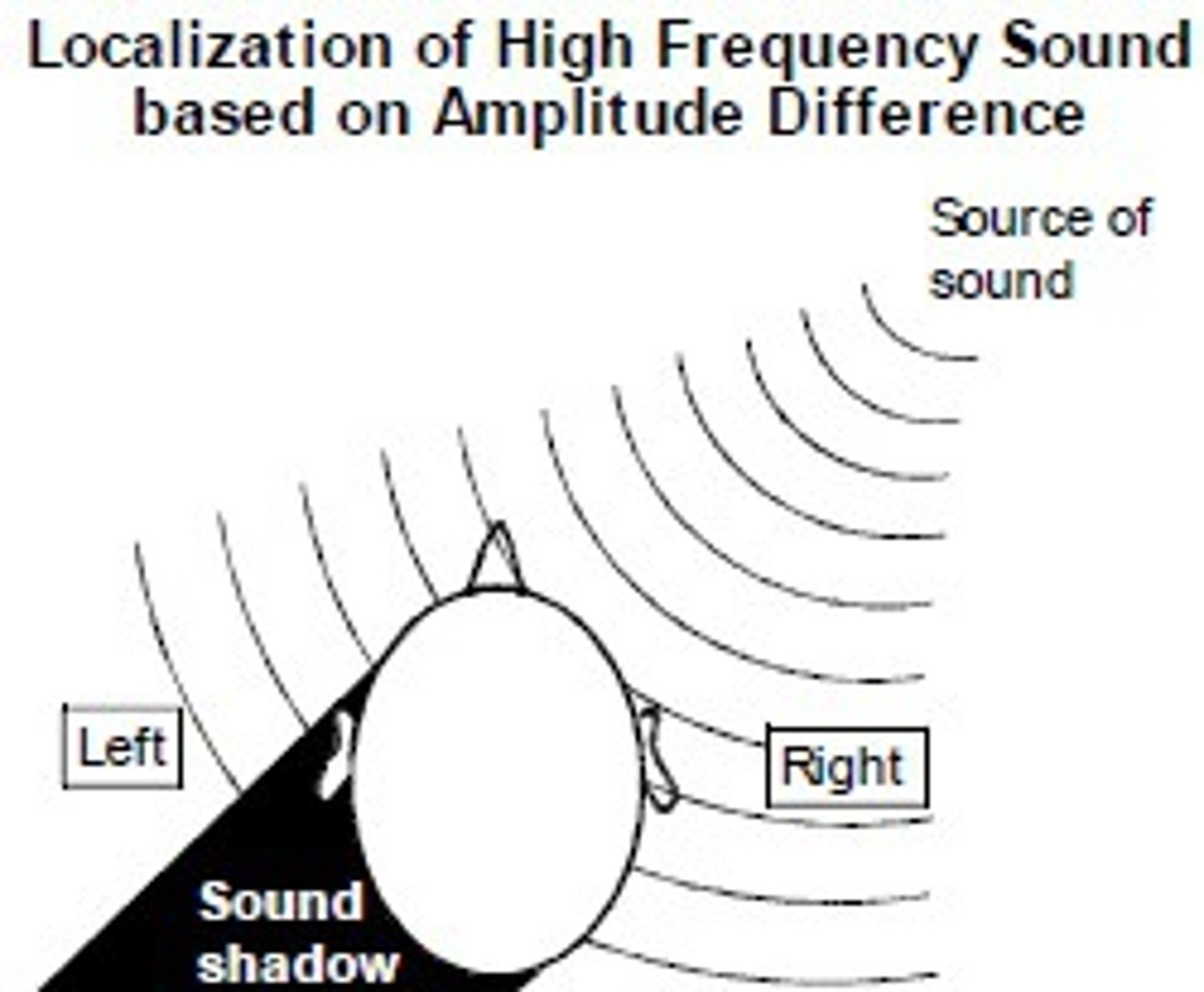
olfaction
The sense of smell, which occurs when receptors in the nasal cavity respond to chemicals. Only sense not processed by thalamus.
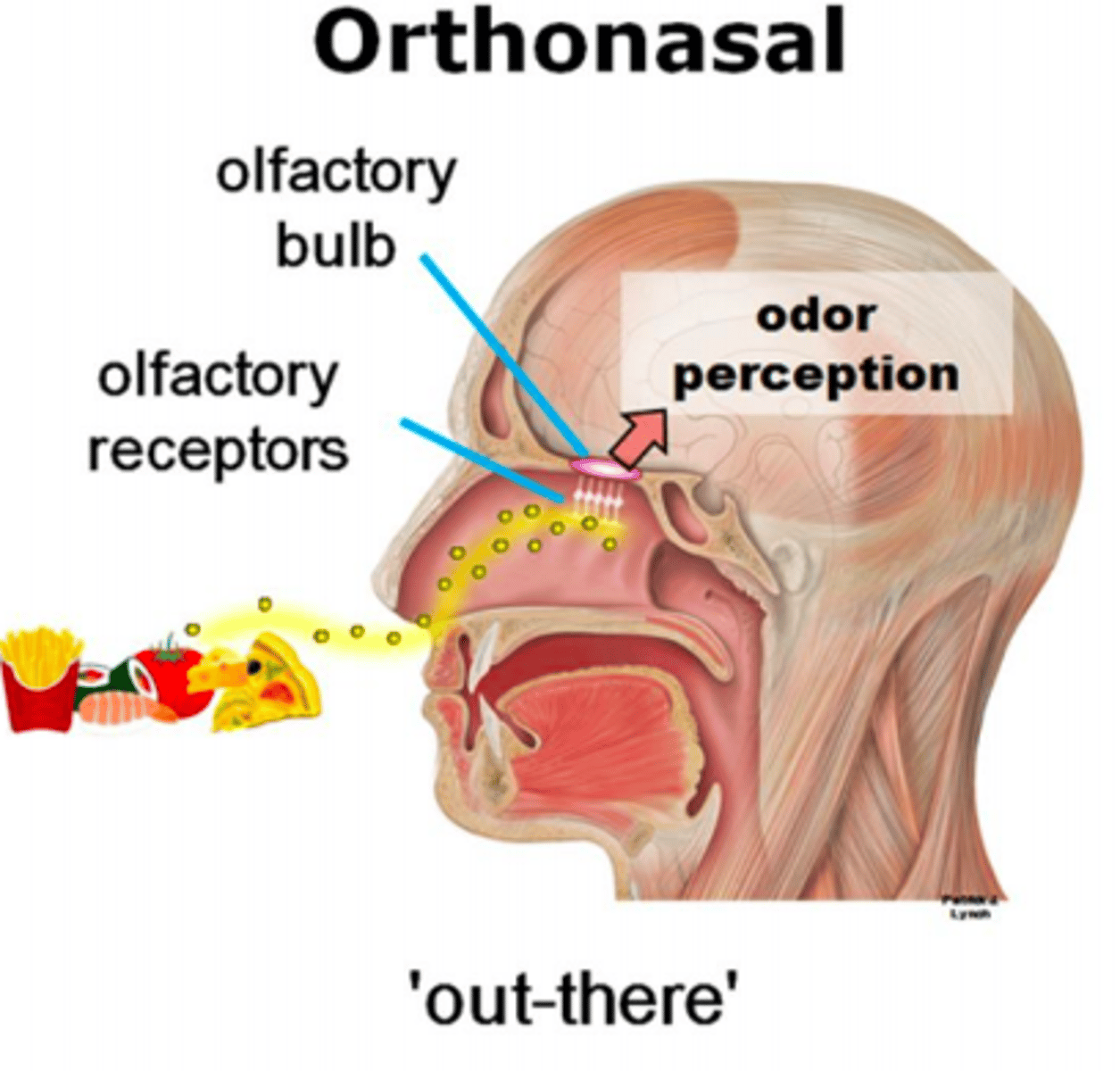
Ponzo illusion
An illusion of size in which two objects of equal size that are positioned between two converging lines appear to be different in size. Also called the railroad track illusion.
stroboscopic movement
The brain's perception of continuous movement in a rapid series of slightly varying images; this is how we perceive motion in film and animation.
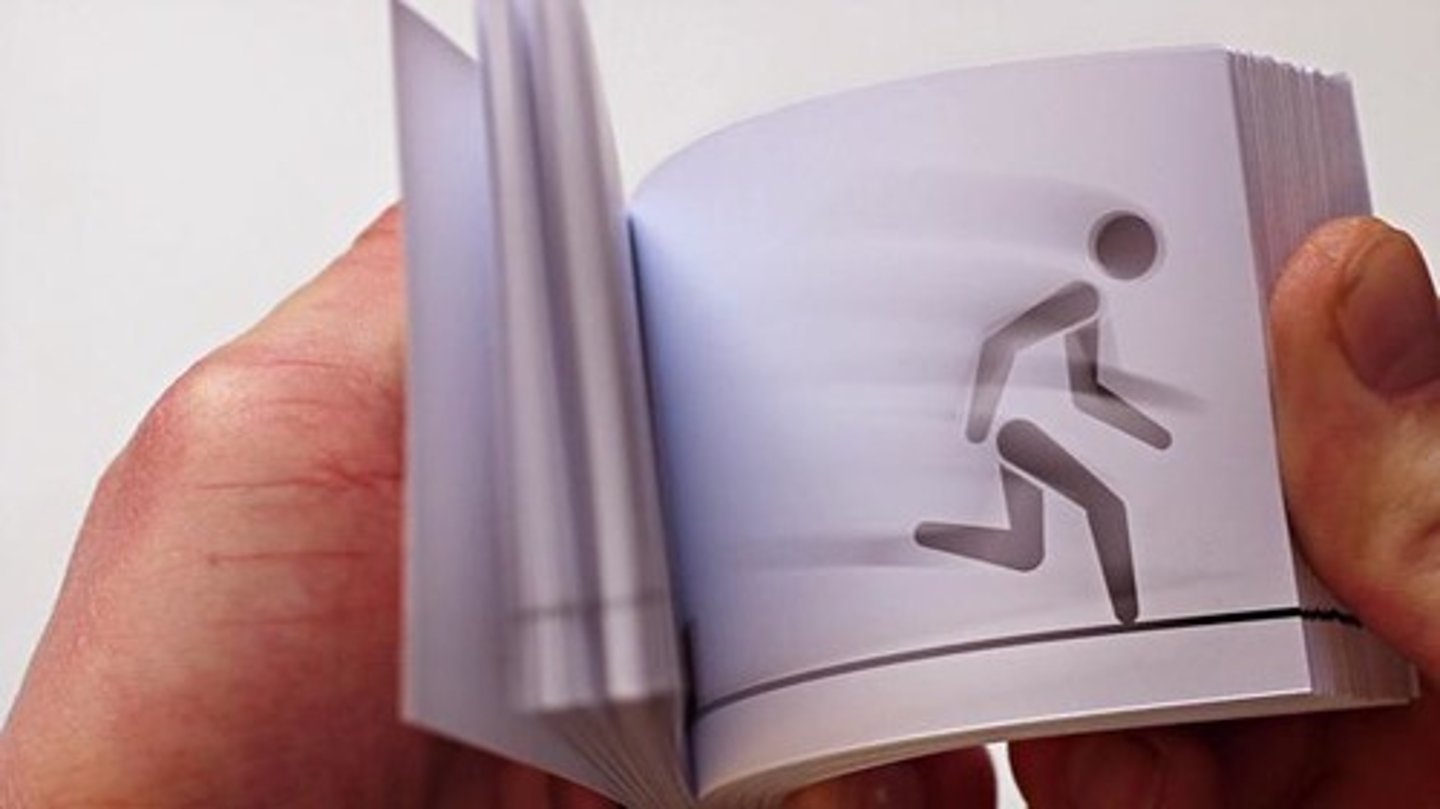
interposition
Monocular visual cue in which two objects are in the same line of vision and one partially conceals the other, indicating that the first object concealed is further away.

context effects
A given stimulus may trigger radically different perceptions, partly because of our differing perceptual set or perceptual expectancy, but also because of the immediate context. Culture or previous experiences can influence how we perceive our situations. (Top-down processing)
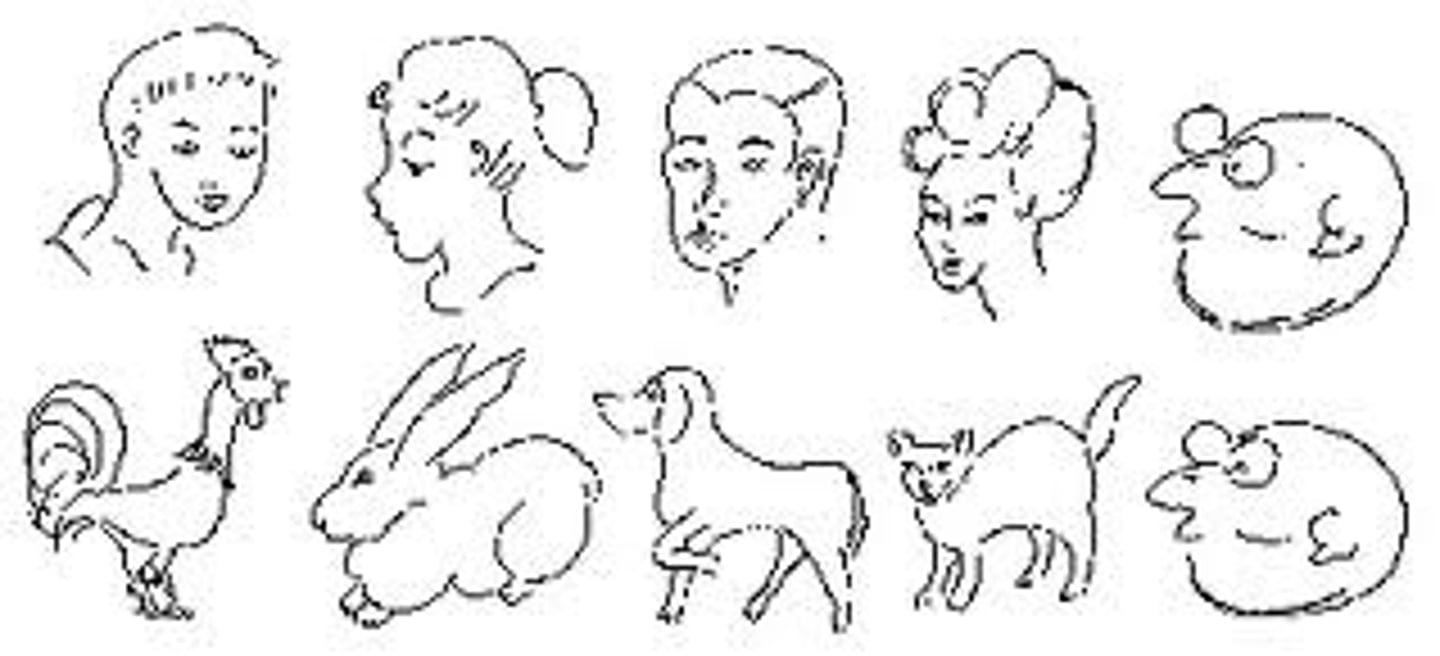
moon illusion
The Moon looks up to 50% larger when near the horizon than when it is high in the sky. Near the horizon it is surrounded by objects that are much smaller than the moon and appears huge in comparison. In the sky it is surrounded by the vastness of the sky so it appears much smaller in comparison.

McGurk Effect
A perceptual phenomenon that illustrates sensory interaction. The illusion occurs when the auditory component of one sound is paired with the visual component of another sound, leading to the perception of a third sound.
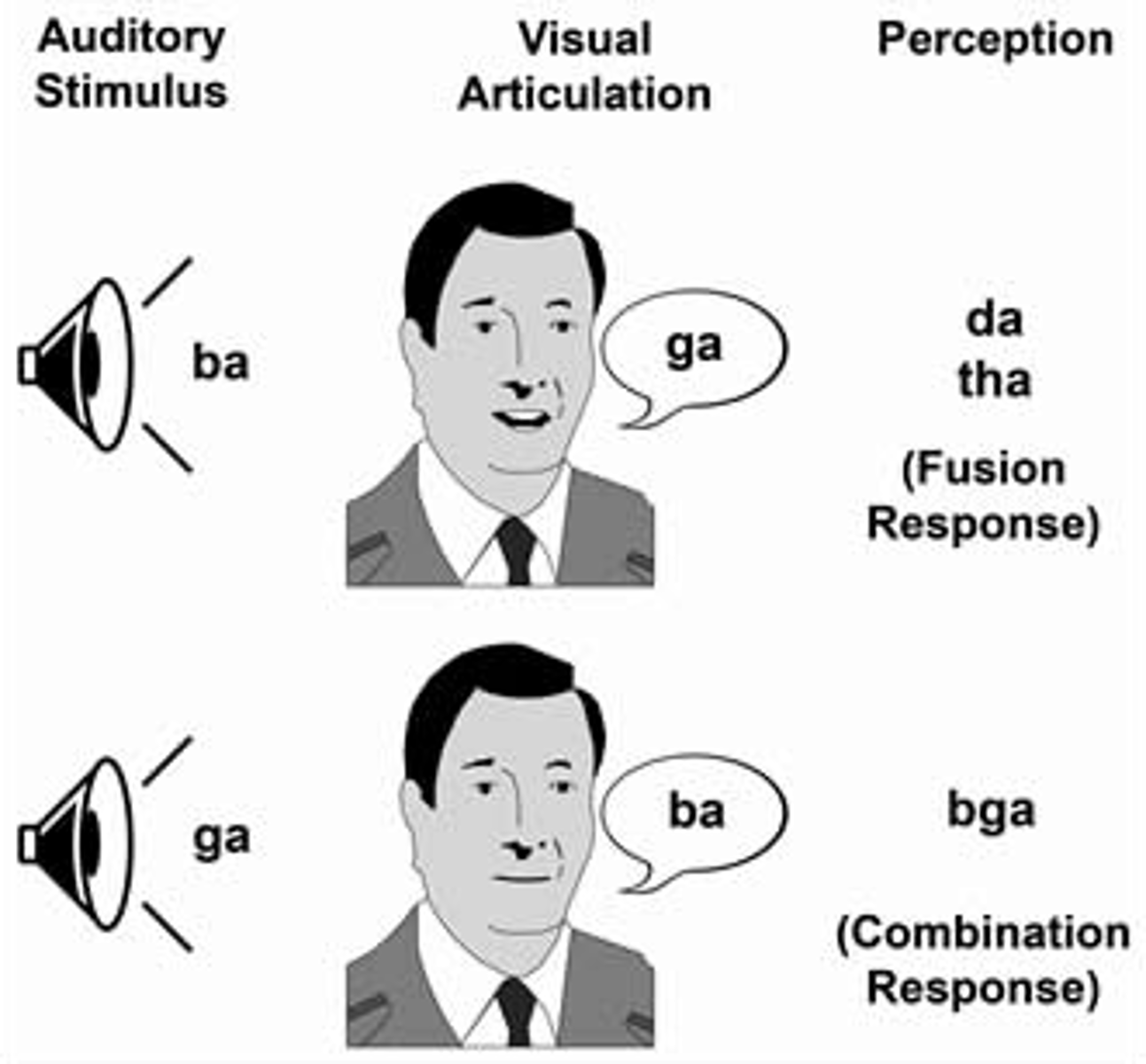
human factors psychology
An I/O (industrial organizational) psychology subfield that explores how people and machines interact and how machines and physical environments can be made safe and easy to use

Extra sensory perception (ESP)
The controversial claim that perception can occur apart from sensory input; includes telepathy, clairvoyance, and precognition.
psychokinesis (telekinesis)
The ability to move physical objects with your mind.
Prosopagnosia (face blindness)
A condition characterized by the inability to recognize faces.
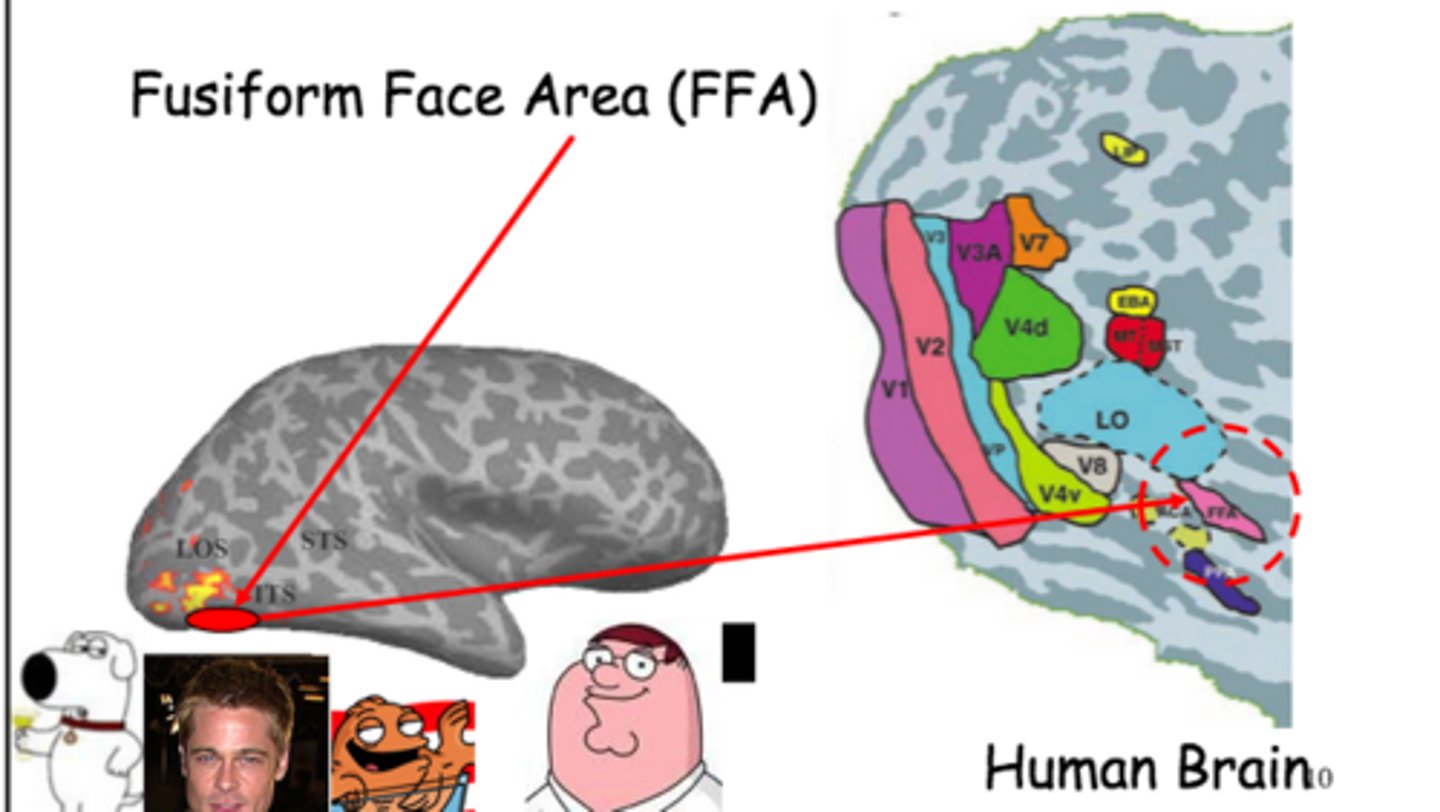
Muller-Lyer Illusion
A famous visual illusion involving the misperception of the identical length of two lines, one with arrows pointed inward, one with arrows pointed outward. Also illustrates how perception is developed by life experiences.
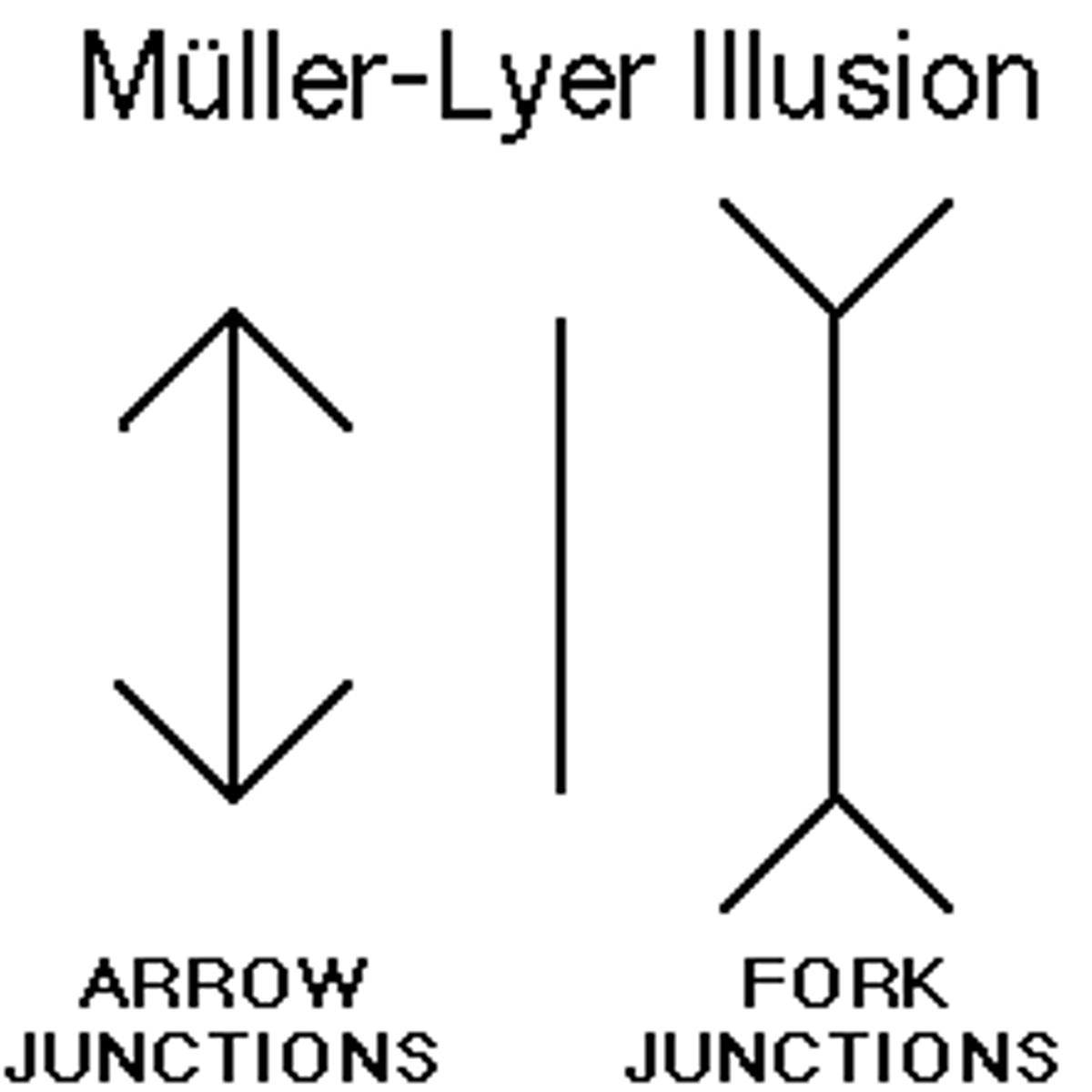
blindsight
A condition in which a person can respond to a visual stimulus without consciously experiencing it (damage to visual cortex but visual information bypasses cortex). NOT "blind spot"
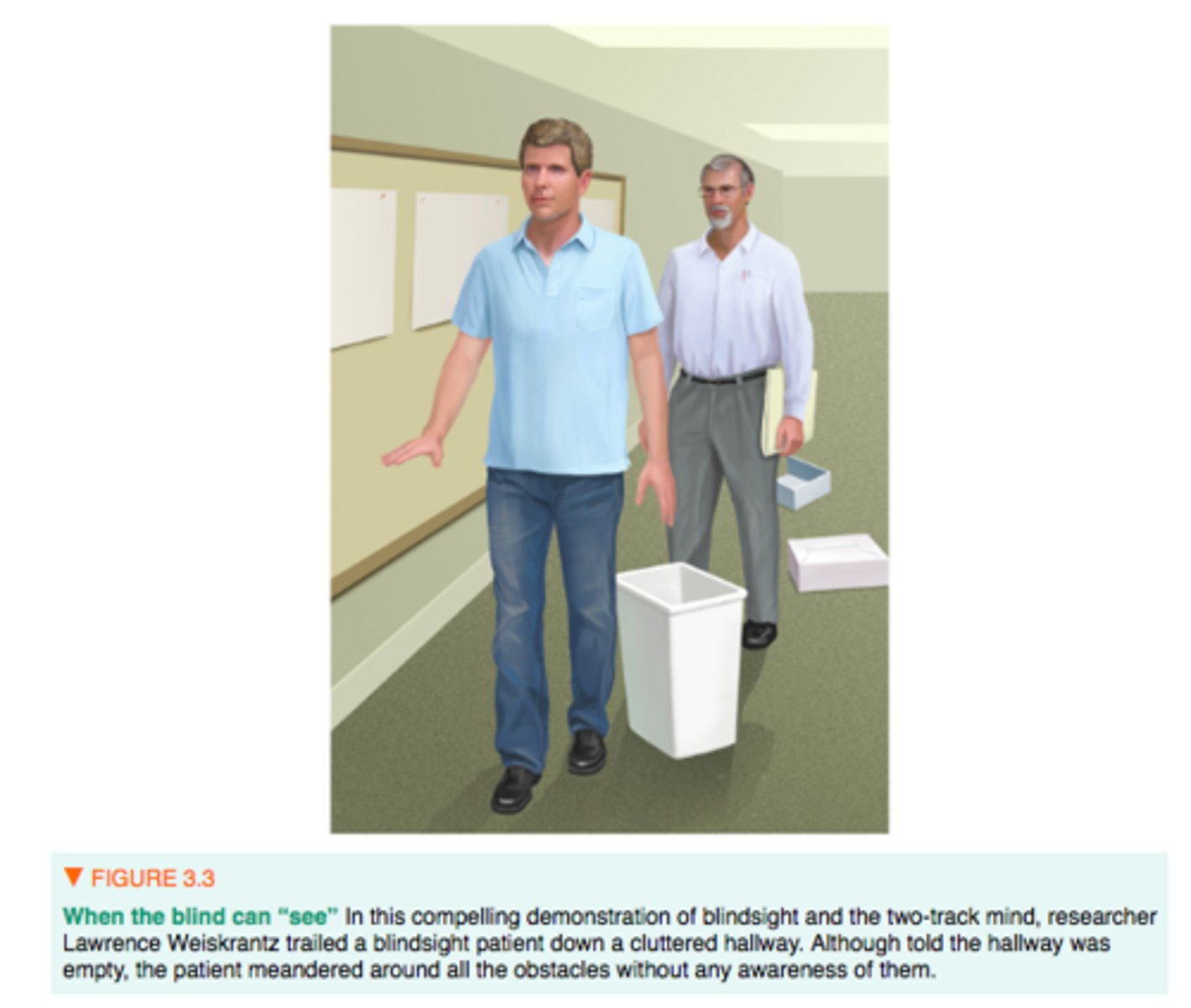
eye diagram
KNOW YOUR EYE PARTS AND FUNCTIONS
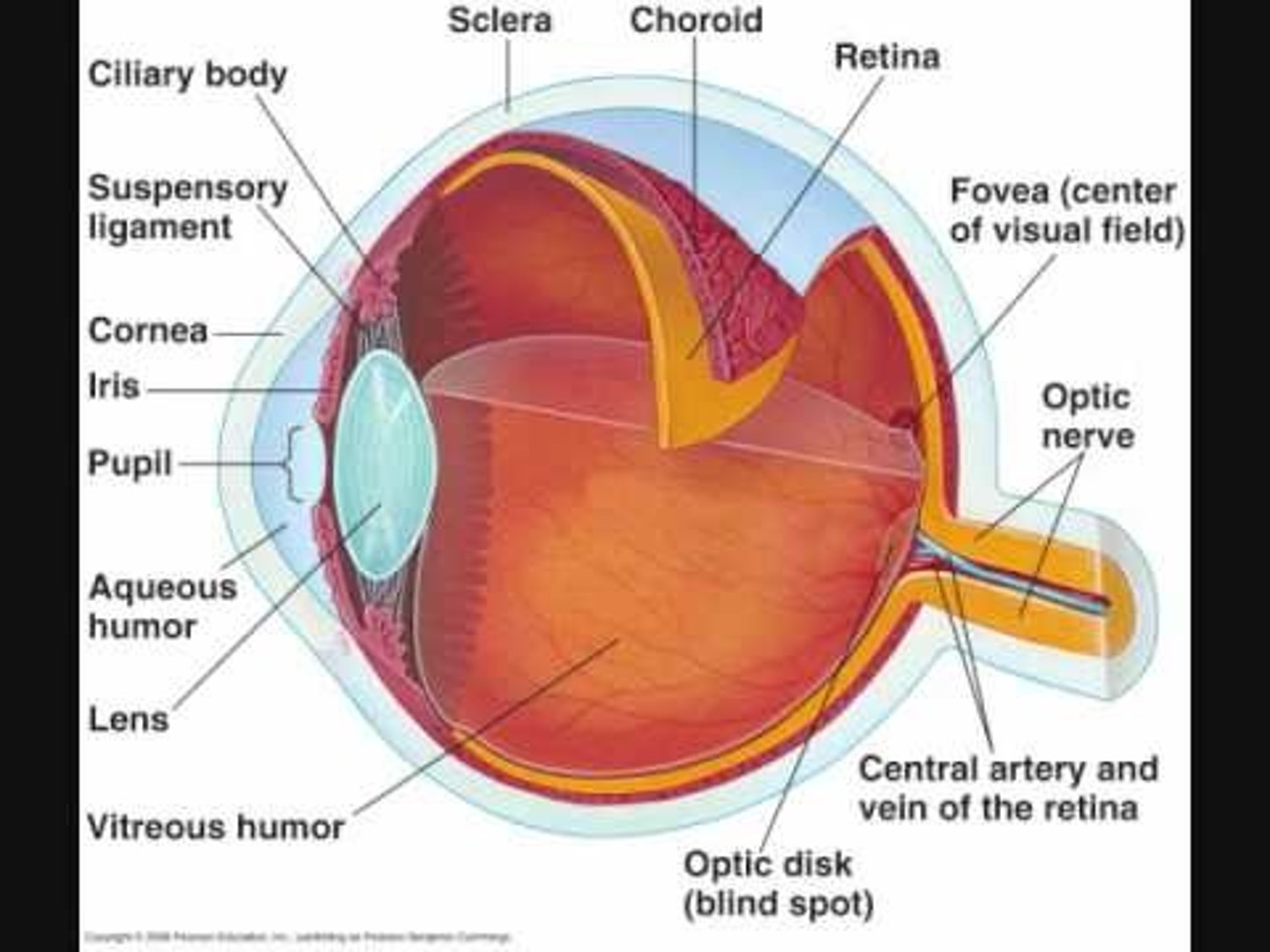
habituation
An organism's decreasing response to a stimulus after repeated exposure to it. After being exposed to a stimulus a lot, an organism doesn't respond as heavily to it. Ex. impact of drugs ...need stronger dose to get same reaction as original time. NOT sensory adaptation!
visual cortex
Sensory input originating from the eyes traveling to the thalamus and then to the cortex is received and integrated. The right areas process information from the left eye, and the left processes information from the right eye. INTERPRETS visual information for brain. Ex. cornea replacement (eye works) but person can't interpret/process correctly.
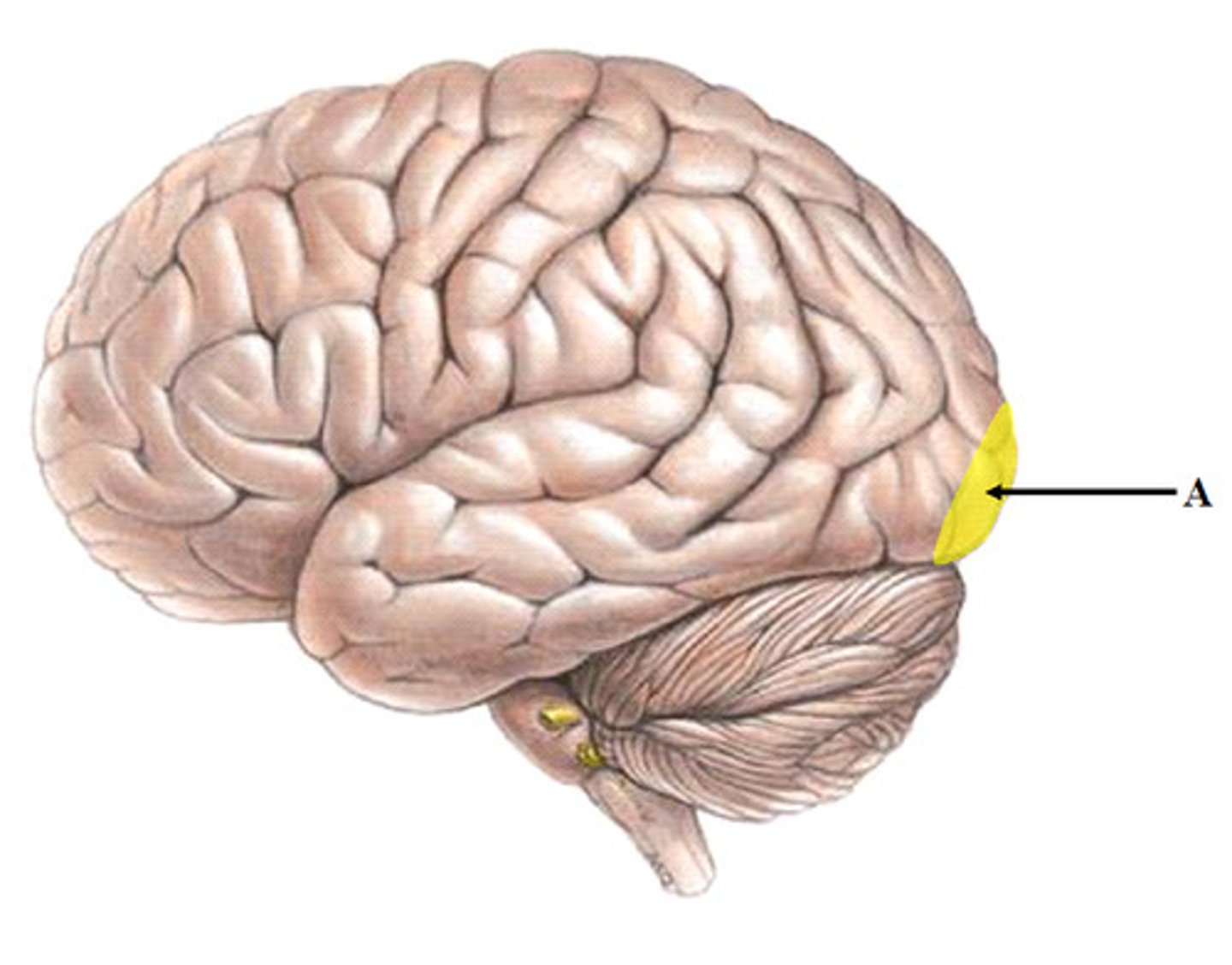
size constancy
Perception of an object as the same size regardless of the distance from which it is viewed.

Thalamus
The senses flow to the brain's hub of information and to the primary sensory cortex for all of the senses except olfaction.
Photoreceptors
Light-sensitive cells, (the rods and the cones) that are found in the retina of the eye.
Iris
The colored part of the eye which helps regulate the amount of light entering the eye. When there is bright light, the iris closes the pupil to let in less light. And when there is low light, the iris opens up the pupil to let in more light. Focuses light rays onto the retina.
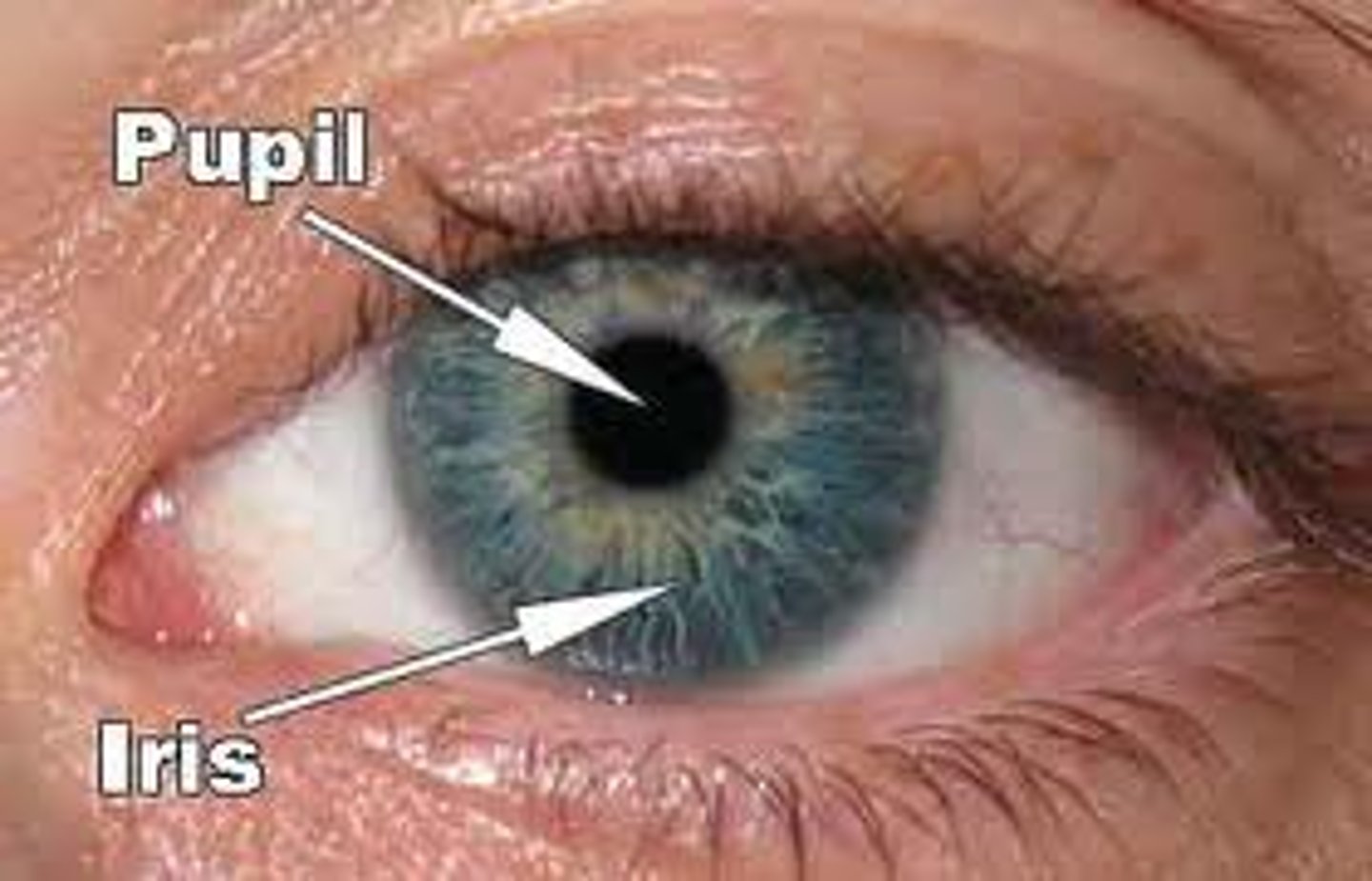
inattentional blindness
Failure to detect stimuli that are in plain sight when our attention is focused elsewhere.
Ear diagram
KNOW YOUR EAR PARTS & FUNCTIONS
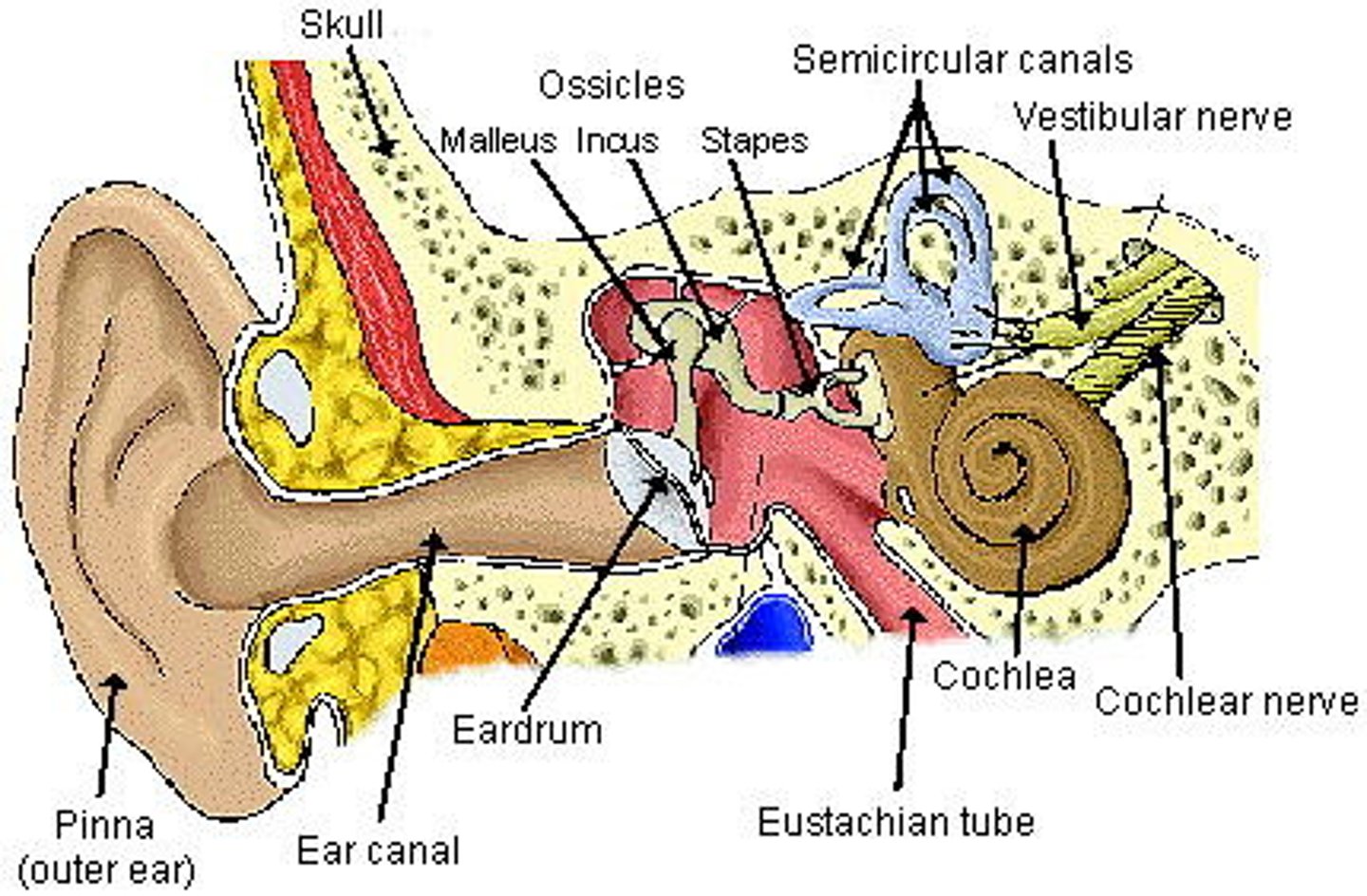
Timbre
The perceptual attribute relating to the quality of a sound. Two perceptually different sounds with the same pitch and loudness differ in their timbre.
Ernst Hilgard - Hidden Observer test in hypnosis
Hypnosis involves dissociation. A disruption of normal processes of memory and attention. Ex. a person under hypnosis may not report feeling physical pain.
gustatory receptors
Chemoreceptors on the tongue that respond to chemicals in food and the tongue tastes bitter, salty, sweet, umami and sour, but not spiciness. Ex. "supertaster" is a person who tastes certain flavors and foods more strongly than other people.